

9 Popular Boats With Lifting Keels (With Pictures & Prices)
If you are looking for a sailboat, you might want to consider one that features a lifting keel.
Lifting keels allow you to explore shallower waters, reduce drag, or other advantages when the keel is lifted.
Here are the boats you should check out first!
Table of Contents
What is a Lifting Keel?
As you probably know, the keel of a boat is the longitudinal structural device on the bottom of your hull.
On a sailboat, the keel serves as an underwater fluid machine that helps to minimize the lateral motion of the vessel that is under sail, as well as acting as a counterweight to the lateral force that comes from the wind on the sails which can cause it to roll to the side.
A lifting keel, sometimes known as a centerboard, is a keel that retracts into the hull of a sailboat or pivots and allows for certain advantages.
A lifting keel’s main function is to provide a lift to counter the lateral force that is created by the sails. This allows the sailboat to move other directions other than downwind.
Because these keels lift into the hull, you would be able to take your vessel into shallower waters.
In addition, a lifting keel is ideal for:
- Moving the center of resistance.
- Reducing drag.
- Removing the boat from the water and trailering it.
Centerboards are different than other types of keels, such as a ballast keel, because they do not contribute to the overall stability of the vessel because they are not as heavy and instead they only provide lateral resistance.
Great Boats with Lifting Keels Under $30,000
If you are looking for a boat that features a lifting keel and all that comes with it, you are in luck!
Below, I have compiled a list of great boats that feature a lifting keel.
1. Parker 235 Mini Cruiser

The Parker 235 Mini Cruiser is a small sailboat that should be great for sailors who would like to trailer their boat and explore multiple destinations.
This sailboat exhibits excellence both afloat and while onshore. This features high performance due to its long waterline, stable hull, and a deep low center of gravity.
This boat features a custom boat trailer and is easy to launch and as well as to trailer.
This boat is 23’ 5” in length. Despite its smaller size, there is no compromising with the internal accommodations. The boat featured 2 berths, a galley, and a head compartment.
This boat also has a lifting keel which reduces the draft by 3’ 6”.
This boat can be found used at a price of around $20,000.00.
RELATED: Common Problems With Parker Boats .
2. Hunter 22

The Hunter 22 sailboat is a perfect small daysailer that features the capacity to stay aboard overnight. This vessel is ideal for up to five passengers and features a large cabin.
This boat is 21’ 4” in length and is easy to launch, rig, and trailer when needed.
This boat features a lifting keel that reduces draft by 2’ 6” when lifted up.
This boat has a starting price of $29,990.00.
3. BayRaider 20
The BayRaider 20 manufactured by Swallow Yachts, is a small open sailboat that is ideal for families or sailors who are looking for something stable and safe.
This boat has features that make it ideal for beginner sailors including the ability to keep the ballast tanks full for added stability.
This vessel also features a two-masted ketch that gives an advantage over a single-mast rig because it allows for a quick reduction of sail.
This boat is almost 20 feet long and is light enough to be trailered or handled by one person.
This boat features a lifting keel that reduces the draft by 3.8 feet when lifted.
This boat has a starting price of $27,750.00.
4. Catalina 22 Sport

Catalina strives to encourage sailors who are interested in racing with the Catalina 22 Sport. This boat is small and measures at 23’ 10”.
This boat also has a cabin that features berths for up to 4 adults. This boat is a great choice for those looking for speed and easy maneuverability while still offering the ability to stay aboard overnight.
This boat has a lifting keel that reduces the draft of the boat by 3’ 2” while lifted.
This boat has a starting price of $23,550.00.
5. Marlow-Hunter 15

The Marlow-Hunter 15 is a safe and versatile daysailer for families or individuals who new to sailing. This boat was designed with sailing novices in mind and features high sides, a contoured self-bailing cockpit, and a wide beam that was built for comfort.
These safety features will allow peace of mind for parents and brand new sailors.
This vessel is also easy to trailer, rig and launch.
With a length of 14’ 6”, you can fit a crew of up to four onboard but this boat can also be handled solo.
This vessel features a lifting keel that reduces the draft by 3 feet when lifted.
This boat features a highly affordable starting price of $10,123.00.
Models Between $30,000.00 and $100,000.00:
6. feeling 326.
The Feeling 326 was manufactured between the years of 1987 and 1999. This boat is a cruising sailboat that is 32’ 6” in length and comes with 2 cabins, 6 berths, and 1 head.
This boat is great if you plan to go out for long journeys with multiple people.
Even though this boat is an older model, you should still be able to expect quality sailing from them.
This boat also features a lifting centerboard that reduces the draft by 2’ 7”.
Depending on the year and the seller of the vessel, these boats are selling for an average price of between $30,000 and $45,000.00.
7. Norseboat 21.5

The Norseboat 21.5 is the largest model in the Norseboat line with a length of 21’ 10”. You can get either a Cabin or an Open model for this boat.
You can customize this vessel based on your needs and other factors. You can construct a standard or semi-custom Norseboat.
This boat features a lifting centerboard that reduces draft by 2’ 4” when lifted.
Depending on the layout and chosen options, this boat has a starting price of $37,490.00.
Boats Over $100,000.00:
8. alubat ovni 365:.

From the manufacturer Alubat, the Ovni 365 combines their experience in centerboards and high performance to create a vessel that is both comfortable and high performing.
This boat is great whether you are traveling upwind or downwind. This boat is great for both long trips or for simply cruising up and down the coast.
This boat is 39.17 feet long and features a galley as well as a front and rear cabin.
This boat features a lifting centerboard that reduces the draft by about 5.18 feet when lifted.
Depending on the year and specifications of this vessel, the price could range from $100,000 to $300,000.
9. Southerly 42 RST

Southerly makes a mono-hull 42 RST that is an offshore deck saloon sailboat that was built for cruising. This boat has a length of 42’ 2” and could be equipped with either 2-3 cabins, 4-8 berths, and comes with 2 heads.
This boat is great for taking multiple people out on the water. While these are no longer in production, they were made between the years 2007 and 2017.
This boat has a lifting keel that reduces the draft by 6’ 1” when the keel is up.
Depending on the year and the condition, this boat could cost a minimum of $250,000 but if often over $300,000.00.
10. Gunfleet 43

The Gunfleet 43 is a top of the line vessel with many options for customization. This boat is large and luxurious with a length of 44’ 1”.
This boat features a standard layout with either 2 or 3 cabins, or you could get a custom-built version that also has 3 cabins.
This vessel offers high-end luxurious features that are ideal for long trips and even vessels that you would consider for living aboard.
This line features an optional lifting keel that would reduce draft by 4’ 4” when lifted.
This luxurious and custom-crafted vessel has a large price tag of over $800,000.00.
Keel Types and Performance:
The lifting keel is not the only keel that is available for your vessel. Each keel type is built for a different type of performance.
Some of these keel types include:
- Fin Keel with Spade Rudder
- Fin Keel with Skeg Rudder
- Lifting or Swing Keel
- Twin or Bilge Keel
Make sure before you buy your vessel, you consider the type of performance you are looking for on your vessel and research the ideal keel for you.
This can help you when selecting which boat to purchase and will help you get the maximum performance and use out of your vessel.
If you do not buy the boat with the proper keel type , then you will not get the necessary performance needed. Some keels are made to be more stable, some are made to be more versatile, and some such as the lifting keel is made to be able to be optional depending on what type of activity you plan to achieve in your vessel.
A lifting keel is a great option for those who are looking for shallow draught, speed, efficiency, and the ability to plane your vessel early.
The lifting keel is not ideal if you are planning to use it to offer additional stability. If you are looking for additional stability, you will want to look at different and heavier keel options.
If that sounds ideal for you, you will benefit from one of the many daysailers or overnight vessels that offer a lifting keel listed above.
Click to share...

- Featured Listings
- Beneteau Sailboats
- Excess Catamarans
- Powerboat Listings
- Sailboat Listings
- Catamaran Listings
- Recent Price Drop
- See All Team Members
- Why Hire Team Murray Yacht Sales
- Your Saved Searches
- Ask a Question
Hydraulic Lifting Keel On Beneteau Oceanis 34.1
Best of both worlds.
The expert design team at Beneteau Sailboats has implemented a safe, stable, & convenient system to package the advantages of both deep and shallow draft keels. A hydraulic lifting keel offered on the Oceanis 34.1 maximizes the hull’s potential when deployed, yet gives access to shores with shallow waters when retracted.
When deployed, the lifting keel brings the performance of a very deep ballast in all points of sail. Without a weighted bulb on the bottom of the keel, this design also saves weight and limits drag.
The option is ideal for sailors who want the critical performance boost a deeper keel offers but also need shoal draft to get to their marina. Pensacola Bay, for instance, is extremely deep yet the marinas and bayous get shallow quickly and require a compromise.
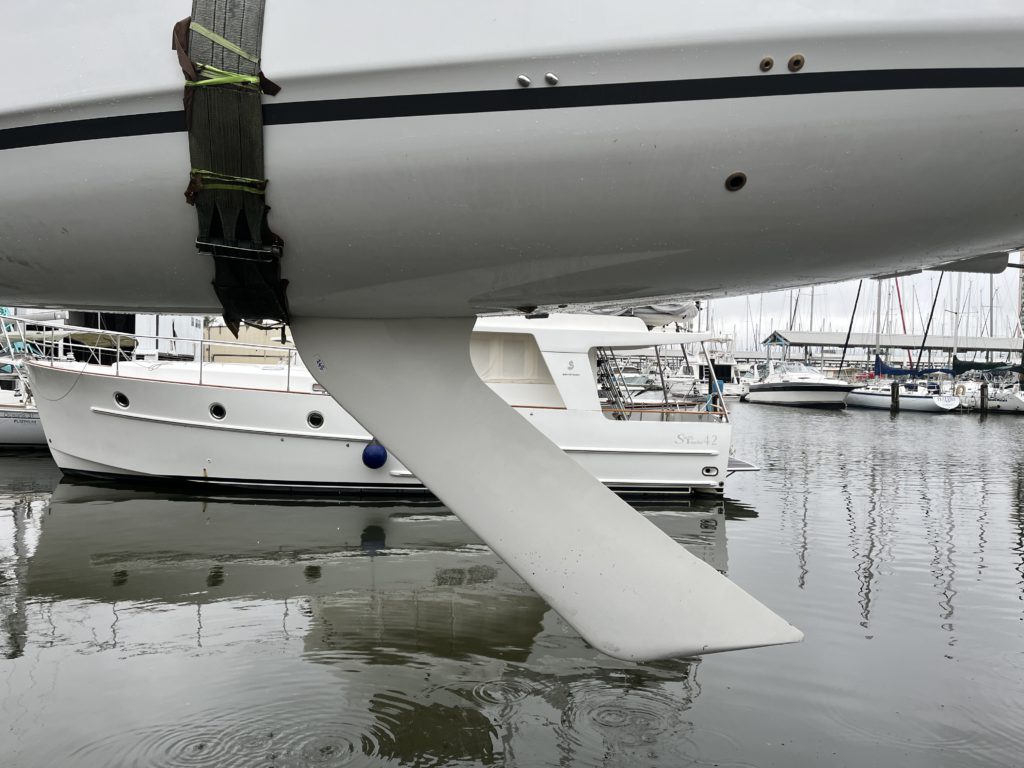
When deployed, the performance draft is 8’4″
When retracted, the draft measures in at 4’1″
Ballast weight: 3,319 lbs (down from 4,099 lbs on the shoal draft)
The top of the keel pivots on a casing molded along the outside of the hull. This centerboard remains outside the hull & gives us a completely watertight structure. *For maximum stability and hold, the top of the keel pivots in a car inside of the casing*. A linear arm lifts keel up and down at the push of a button and is hidden inside of the dinette table.
The keel locks at one of 2 fixed positions – either fully deployed or fully tucked. The keel can only be deployed when the engine is underway, negating the risk of a badly positioned keel under sail. The ability to lock the keel in adds to the stability compared to operating it halfway deployed strictly on hydraulic pressure. It is important to understand that the draft cannot be adjusted to fit within the current depth and you must sail at one of the two positions (8’4″ or 4’1″).
In addition to adding performance and access, the system is a very safe one. In the event of a collision, the hydraulic cylinder pressure is released, freeing the keel so as to prevent damage.
The system is extremely easy to operate, with straightforward controls to raise and lower the keel. The control box is located near the throttle at the starboard helm station, and has all of the controls you need to operate your lifting keel.
See below placement of control:
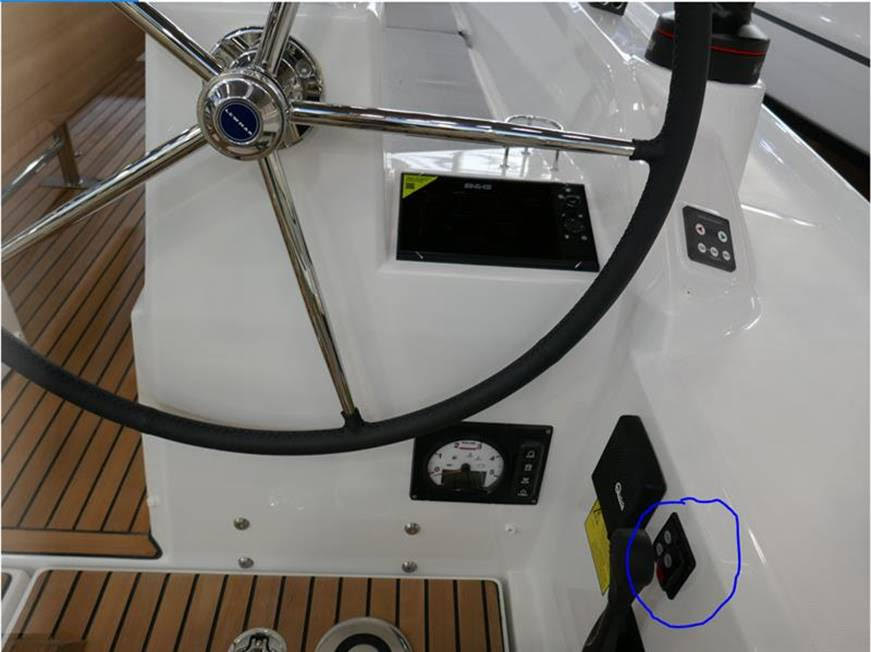
The below tutorial video gives an overview of the keel operation and controls.
The popular new 34 foot cruiser has three keel options: a shoal draft, deep draft, and a lifting keel designed for the best of both.
The performance lifting keel is a safe, stable, & convenient system using hydraulics to lock the keel at one of 2 fixed positions – either fully deployed or fully tucked.
When deployed, the performance draft is 8’4″, when retracted, the draft measures in at 4’1″ …
The keel pivots on a structural support on the hull, keeping the entire system watertight.
The keel will deploy in under 30 seconds and retract in 20 seconds.
Other Keel Options
The popular new 34 foot cruiser has two other keel options in addition to the lifting keel, a shoal draft and a deep draft. See below outline for different options.
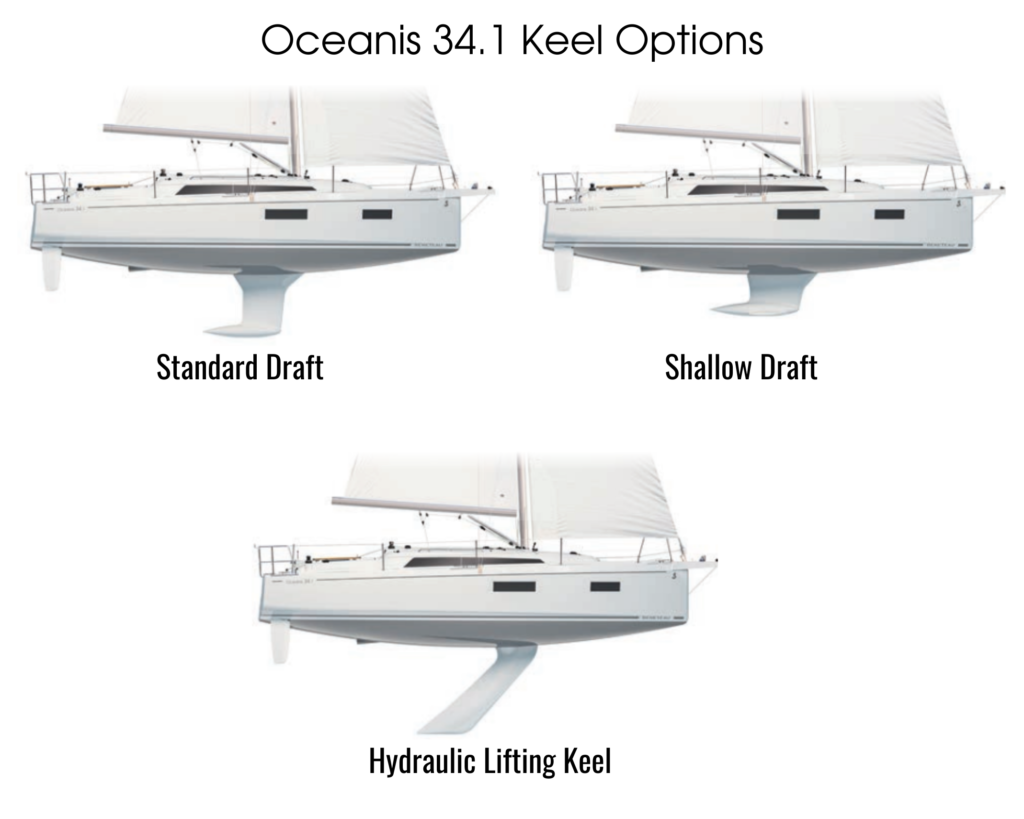
For more information about the Oceanis 34.1 or her keel options, fill out the contact form below
" * " indicates required fields
Yachting World
- Digital Edition

Ovni 370 review – go-anywhere shoal draught cruising
- Toby Hodges
- July 19, 2022
Ovni’s smallest new model, the Ovni 370 is packed with smart thinking to appeal to those who want to cruise all waters, says Toby Hodges
Product Overview
Manufacturer:, price as reviewed:.
With its distinctive range of bare aluminium lift-keel cruisers, Alubat’s Ovni brand has been synonymous with bluewater cruising since the 1970s. After a barren period it came out with a contemporary new Ovni 400 two years ago and has followed that up with an arguably more innovative and approachable shorter model, the Ovni 370.
The Ovni 370 shares some of the styling of the 400, in particular the angular and voluminous look with full forward sections, so it shan’t win any beauty prizes. However, Ovnis have always attracted more for practicality than aesthetics, and this model certainly packs in the features for its length.
The Les Sables-d’Olonne yard wanted the Ovni 370 to have a true deck saloon, a panoramic heart as opposed to the (optional) lower single level format of the 400 – clearly a popular decision which all 17 buyers so far have chosen.
Once you accept you need to climb up and down steps to get through the boat, the benefits are multifarious. This is particularly true of the Ovni 370, which has many of the staple ingredients bluewater sailors will look for even at this size, including a deep, protected cockpit, a pilot berth in the deck saloon, wet hanging stowage and a proper navstation.
Another benefit is the stowage space below a deck saloon – enough for 300lt water and 300lt diesel tanks in the Ovni’s case.

The transom skirt with arch above is a recipe Ovni has perfected. A block and tackle system is used for the dinghy and the liferaft has a prime central location. Photo: Andreas Lindlahr/EYOTY
Built for distance
Alubat says the design development began after it received many requests for its old 365 model. However, that was a Category B (offshore) rated design and the majority of its clients today are couples who want to go long distances. Nina Karlseder from Création Brouns Architecture, one of the five designers who worked on the Ovni 370, explained the major challenges involved with trying to make a Category A yacht with a lift keel at this size and volume.
The keel, which lifts completely inside the boat to allow for beaching, needed to be kept light enough to raise manually yet heavy enough for stability purposes when lowered.
Meanwhile the hull needed to be stable and light in the right places. So a light aluminium plate was chosen, milled into a NACA profile, and over three tonnes of ballast was used in the hull to make up the necessary righting moment. The 260kg ballasted centreboard has a safety release in case of grounding and a plate protecting the bottom of the boat for drying out.
The result, the yard argues, is the least expensive new Category A lift keel yacht. But what is it like under sail?

The voluminous bow and hard chines create significant living space and helped the designers achieve a prime goal of meeting Category A ocean-going requirements. Photo: Andreas Lindlahr/EYOTY
Sailing the Ovni 370
We had a very pleasant late afternoon sail off La Rochelle in 8-9 knots true wind. As mentioned, the centre of gravity needs to be strictly controlled with a centreboard design, hence the relatively short rig and a modest 33m2 Solent jib. The only option for added oomph here is a laminate square-top main and running backstays, as the test boat sported.
Still, the Ovni 370 is not blessed with a shape designed for pointing or upwind speed. Her angular shape has plenty of wetted surface area and in these single figure windspeeds, 4-4.5 knots were average beating speeds – and at wide tacking angles.
As we know, though, no well-planned cruise should involve sailing to windward, hence we spent the majority of the time under Code 0 averaging over 5.5 knots reaching at 60° to the apparent wind. The helming experience was enjoyable – nice and light on the dual rudder steering with good balance and some feedback.

The views and natural light benefits of a deck saloon. The linear galley has good stowage and solid fiddles, and ajdoins a practical navstation aft. Photo: Christophe Favreau
The helmsman has a snug area between the aft end of the coamings and the davits with clear sightlines forward, while the primaries are within easy reach with handy tailing lockers under the cockpit benches. The mainsheet and reefing lines are led to the coachroof winches, which is a good, protected position for a crewmember, but it does mean that those sailing short-handed will need to rely on the autopilot while they trim sails.
A fixed aluminium dodger is an option, but the very deep cockpit already offers excellent protection behind the high coamings and sprayhood (which links to the bimini on the arch). Sturdy handrails and toerails, good non-slip and a high coachroof make it feel safe and robust around the deck. The foredeck feels huge, and a double bow roller allows the setting of two anchors.

Generous berths and plenty of light in both cabins. Photo: Christophe Favreau
Ovni 370 accommodation
The two-cabin plan makes excellent use of the interior space. The saloon layout is particularly smart, with a table that drops to create a large daybed or pilot berth. The latter uses a carbon pole for a backrest (with cushions), which can be moved to double as a leeboard.
A large wet hanging locker is located beside the companionway, and the decision to split the heads and shower (more potential wet hanging) works well. The heads links through to a work/utility cabin aft, where a bunk can be fitted, but this primarily serves as a wonderful amount of stowage for long term cruisers.
Abundant natural light and lots of light trim make for a modern, fresh look, albeit with a few sharp edges on the window surrounds and bulkhead coverings on the prototype we sailed. The interior is insulated with sprayed cork above the waterline and owners can choose whether to leave this exposed or cover with headlining.
The port aft cabin is capacious, with tall headroom, wide berth, good stowage and a large porthole. Headroom reduces to 5ft 10in in the entrance to the forward cabin. On the test boat this had an extra wide but relatively short (1.85m) berth, and a vast shower room with space for a washing machine abaft the main bulkhead.
Ovni has since addressed the balance of these areas, pushing the bulkhead further aft to increase the berth length – a bonus of building in aluminium over a fixed mould.
If you enjoyed this….
Yachting World is the world’s leading magazine for bluewater cruisers and offshore sailors. Every month we have inspirational adventures and practical features to help you realise your sailing dreams. Build your knowledge with a subscription delivered to your door. See our latest offers and save at least 30% off the cover price.
The concept and design of the 370 is commendable. It fulfils a valuable and obviously popular niche. It’s packed with dependable features, feels robust throughout and offers a more affordable and approachable size level for go-anywhere shoal draught cruising. So much so it makes you wonder who might buy the larger 400 now. It is comparatively good value for an aluminium cruiser, however the price has already increased 13% since last year due to materials costs. It has a quirky, utilitarian style, and is not for those who wish to get places quickly (particularly upwind). But for a new distance cruiser at this size for modest paced sailing in comfort it would make my shortlist.
Use the form on the right to contact us.
You can edit the text in this area, and change where the contact form on the right submits to, by entering edit mode using the modes on the bottom right.
207-236-2166
Current and past projects of Ed Joy Yacht Design
ED JOY DESIGN

Good Hope 56 - Aluminum Lifting Keel Cruising Yacht
A rugged aluminium sailing yacht with a lifting keel for exploring remote cruising destinations.
A Sister for Seal - the Good Hope 56
Aluminum lifting keel expedition yacht .

LOA: 56'-2" LWL: 47'-4" Beam: 15'-10" Draft (keel up): 3'-2" Draft (keel down): 8'-9" Displacement: 55,000lb Ballast: 21,460lb Fuel: 507gal Water: 258gal Engine: John Deere 4045TFM 135HP@2500RPM
A young couple in Capetown, South Africa, with two small children and extensive sailing experience have made the wise observation that there is no better way to raise a family than while circumnavigating. Their search for a suitable vessel to carry them on this physically and spiritually healthy journey has led them to Ed Joy Design. To put it in their own words, "This boat will be our home, our plan being to raise our kids and circumnavigate (using various routes) until we've had enough or the kids beg us to stay in one place. We need a boat that is as maintenance-free as it gets, and safety is a huge factor."
The requirements are for a durable and low maintenance boat that is capable of exploring rivers and tidal basins that are inaccessible to fixed keel sailboats. With some modifications for less extensive work in high latitudes, the design for the rugged Antarctic charter vessel Seal , with her proven lifting keel and rudder, fit the bill perfectly.
The hull, deck and mechanical systems of Eva (the children are great fans of Wall-E) were built at the Jacobs Brothers yard in Grassy Park, after which some talented boatbuilders in the family took over. The design changes from Seal included enlarging the cockpit by moving the pilothouse slightly forward and making the transom more nearly vertical. Since sailing regularly in 50 knot winds is also not part of the plan, the mast can be lighter and taller, improving performance in lighter air.
Retained from Seal is the overall philosophy of simplicity and reliability. Eva's mechanical heart will be a commercially rated, slow turning, high torque diesel engine. Electrical needs will be provided by a small diesel powered DC charger and a large bank of advanced batteries. Refrigeration will be provided by a high capacity ice maker normally seen on sport fishing boats.
The interior layout is well suited for family living with the common areas located between the master stateroom aft and the children's bunk room forward. A spacious galley is on the port side of the keel case, complete with a small settee where children can color under the watchful eye of the cook. An entertainment and homework area is to starboard. The dinette converts to a double berth for extra guests. Meals are consumed in the pilothouse.
The cockpit is laid out for shorthanded efficiency. The unpowered winches are located inboard so the person doing the cranking will have both feet planted to deliver maximum energy to the winch handle.
In 2019 Eva was sold to Compass Light Productions and renamed ArcticEarth . She will be based in Camden, Maine, the town of her conceptual birth and will be used to conduct scientific and filmmaking expeditions to the waters off Greenland, the Canadian maritime and Atlantic provinces, and the Gulf of Maine. The forward bunk area is already ideally suited for this use. The area to starboard of the keel trunk will become a convertible work/sleeping area depending on the needs of the expedition.

Another South African couple employed Ed Joy Design and Jacobs Brothers Boat Builders to create a rugged, aluminum, lifting keel yacht for extensive cruising. They had followed the adventures of Seal and her crew on the internet and were able able to visit Eva while she was under construction not far from their home.
Both husband and wife have been successful in their careers and plan to retire in their early fifties. Thus the interior is laid out for one couple with occasional guests. The sea berths aft and in the pilothouse are comfortable during the passage and the spacious forward cabin awaits when the destination is reached. A throwback feature of the layout the single head, located to starboard with the shower stall opposite on the starboard side. Like Eva , the galley is to port of the keel trunk.
The deck plan shows a comfortable and secure cockpit with a single helm station and a slightly larger pilothouse than Eva . There is a chute for a single large anchor to starboard and a retractable sprit for an asymmetrical spinnaker to port.
Urchin was launched and sea-trialed in October of 2016 and became the star of the Cape Town boat show that year, showing off the amazing skills of her builder. She has lately been hired to conduct expeditions to observe the welfare of sea birds on the remote South Atlantic islands of Gough and Tristan de Cunha. Her exploits can be followed here UrchinSailingExpeditions .

Pilothouse looking aft
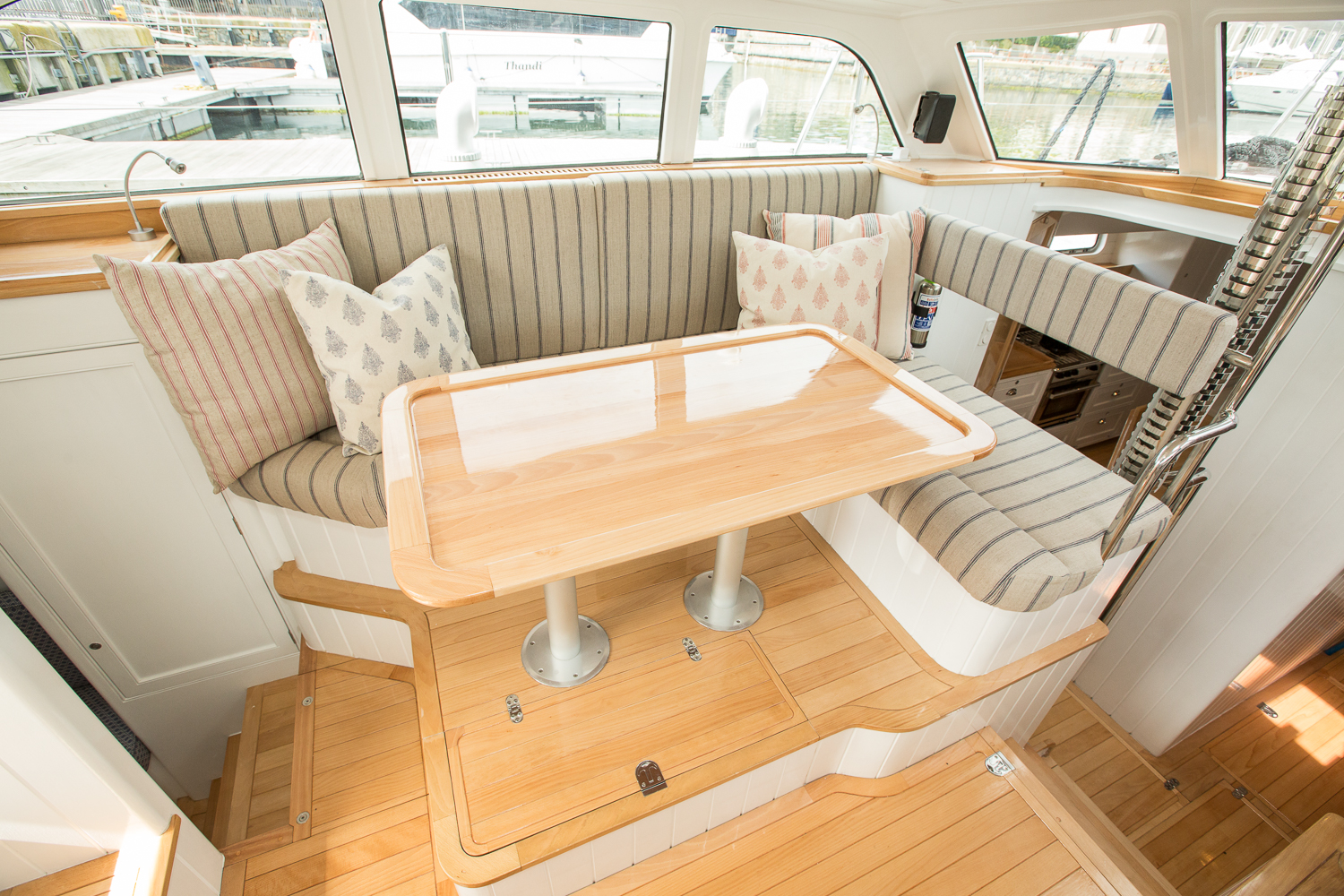
Nav station
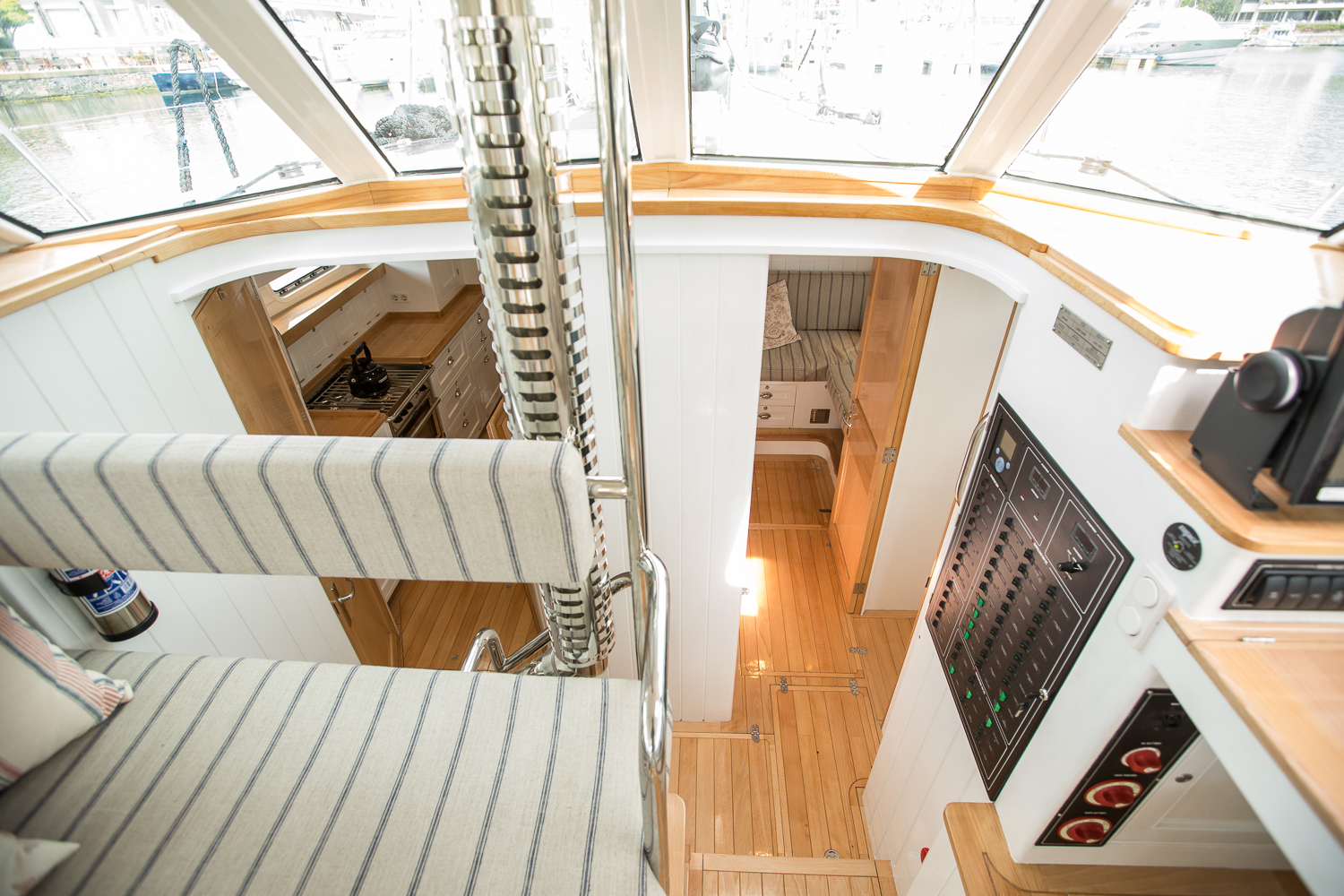
Engine room entrance
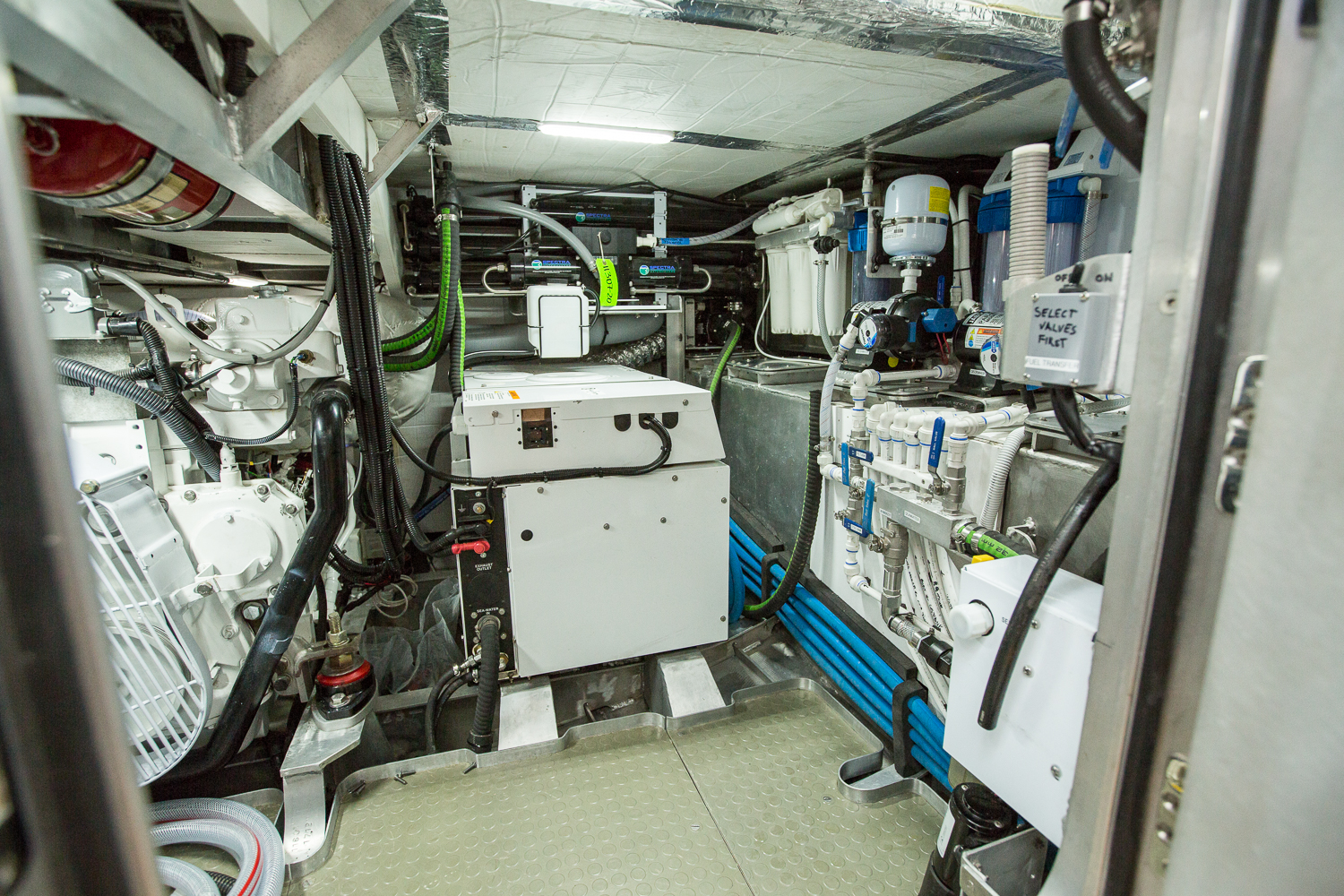
Galley looking aft
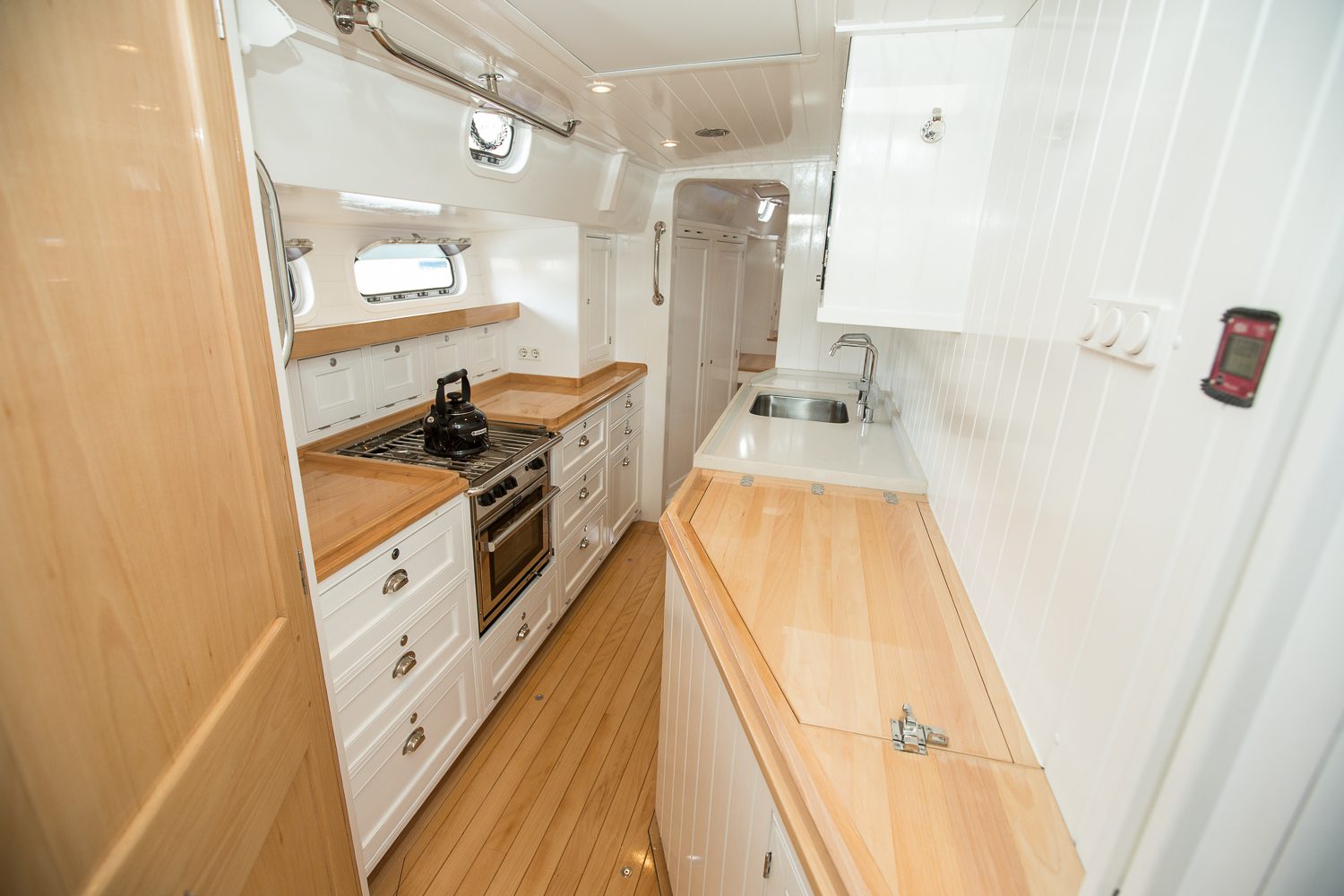
Galley looking forward
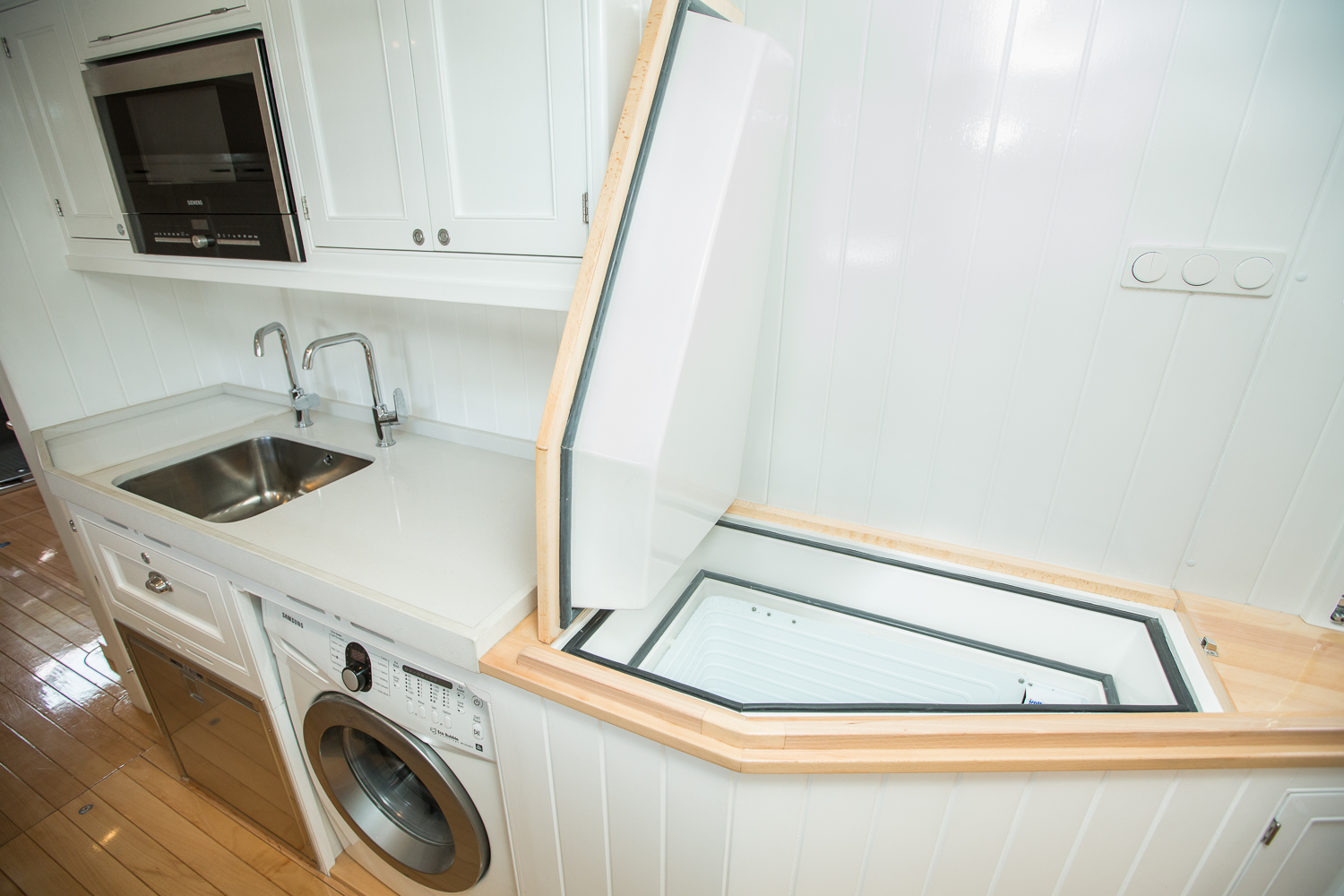
Master stateroom

Master stateroom looking forward
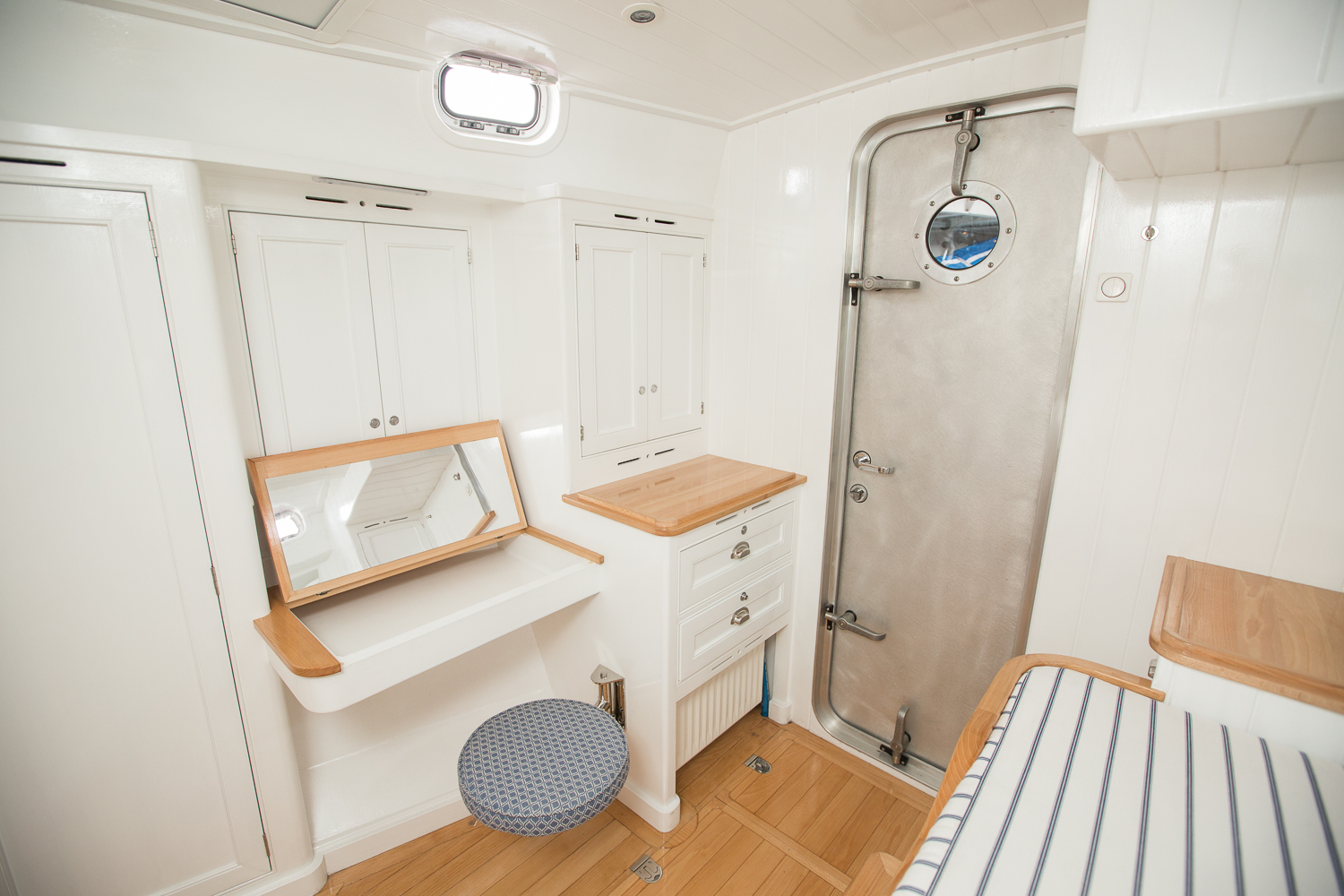
Aft stateroom
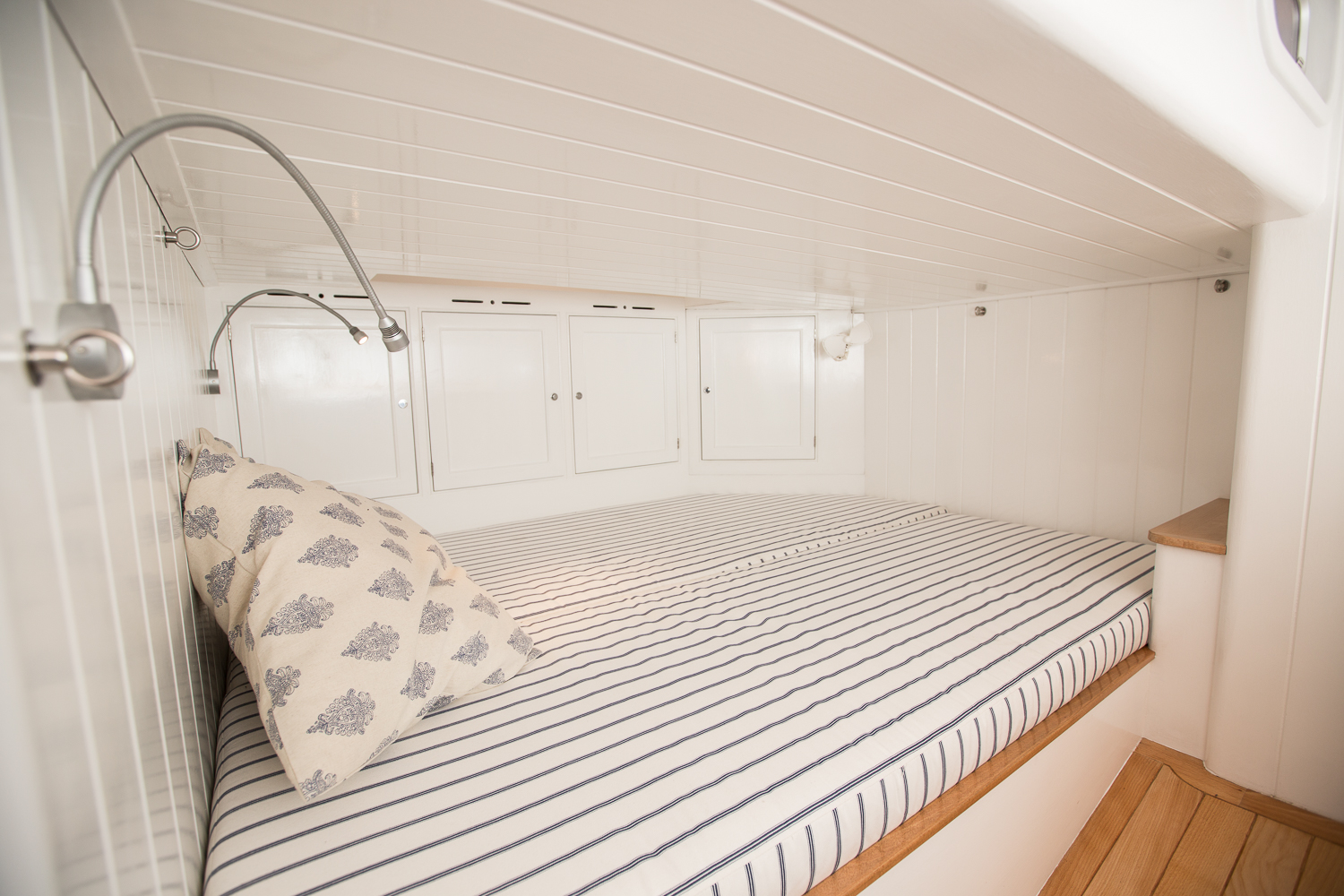
Study plans are available via PDF attachment or post.
Muscongus Bay 18 25' Pentimento 44' Gusto 45' Erica Cabo Rico 42 Cabo Rico 56 56' Seal 58' Ranger 62' Visions of Johanna Kaori Refit 90' Tarni

What’s Behind Different Keel Configurations by Jim Schmicker
In recent years, the superyacht market has become more focused on greater performance by optimizing all aspects of a yacht’s design, engineering and construction.
The choice of the keel configuration is surely one of them.
It’s not surprising that the first three units of the brand new SW105 miniseries will each have unique keel designs to satisfy the requirements of three different owners.
To his end, we’ve asked Jim Schmicker, Vice President of Farr Yacht Design, one of the world’s foremost designer of racing and cruising sailboats, to explain how the choice of the keel design has specific benefits that make it the best choice for a particular owner’s needs.
Jim Schmicker Is Vice President and shareholder of Farr Yacht Design. The company is recognized as one of the world’s foremost racing yacht design studio, based on one of the most impressive winning results records ever compiled by a single company. For more than 30 years, FYD has been developing fast, custom and production cruising yachts. Southern Wind has collaborated with this reputable studio since 1992.

KEEL DESCRIPTIONS
When approaching the cholce of a keel, an owner should be aware that each of the options has advantages and disadvantages but all of them are designed to deliver excellent performance and achieve stringent stability targets while maintaining a similar displacement.
The simplest keel option for construction and installed systems is the fixed keel. The choice of draft for a fixed keel Is decided by balancing upwind performance against reasonable access to ports and anchorages. Reaching and downwind performance is the strongest feature of the fixed keel so long as sufficient stability is achieved. The keel is fabricated out of mild steel plates that are formed and rolled into the correct shape. Considering cost, portions of the keel, such as the leading and trailing edges of the fin, can be CNC machined and the rest hand-faired or the entire keel can be machined. This construction method results in a simple and light structure. Given the shallower draft compared to lifting or telescopic keels a heavier bulb Is necessary to achieve the target righting moment. However, the light fin construction helps to mitigate some of the relatively greater bulb weight. Attachment to the hull is entirely below the cabin sole which facilitates a variety of choices of interior layout with no constraints on either the accommodation or machinery spaces.
Fixed Keel showing Bolt Pattern and Internal Construction

LIFTING KEEL
The lifting keel is a popular choice for superyachts of this size. The ability to raise and lower the keel allows access to ports and anchorages with limited water depth while the deep maximum draft achieves excellent upwind performance. The keel construction is complicated with hydraulic cylinders housed internally to the keel, PLC systems, locking pins to hold the keel In the raised position and adjustable bearing pads to ensure tight tolerances and no movement of the keel In Its trunk while underway. The high number of moving parts and complex hydraulic control systems have associated installation and maintenance costs. The keel trunk takes up significant space In the accommodation but with clever integration with other aspects of the interior its impact can be diminished. The keel is typically constructed out of high strength carbon steel plates welded together and CNC machined to an extremely high level of accuracy. As such, advanced foil sections can be used which results in higher lift to drag ratios being achieved. The lower portion of the keel fin, below the hull in the raised position, is tapered to improve lift efficiency, optimising the amount of surface ares and reducing drag.
Lifting Keel with Tapered Lower Portion Showing Hydraulic Cylinders, Trunk and Bearing Pads

TELESCOPIC KEEL
The telescopic keel combines some of the benefits of the fixed keel and lifting keel. It achieves a similar amount of draft adjustment as the lifting keel with only minor intrusion into the interior. The upper, fixed part of this design is installed partly inside the hull but mostly outside and below the hull surface. The lower, moving part retracts into the upper part and incorporates a foil-shaped shell that slides over the outside of the upper part. Similar to the lifting keel, the telescopic keel is a complex installation with a high number of moving parts and hydraulic systems with associated costs. The fin is typically constructed out of high strength stainless steal plates welded together and CNC machined to an extremely high level of accuracy. The un-tapered planform shape required to house the hydraulic cylinders and structure supporting the lower part results in higher surface area, The fin components have a relatively higher weight and center of gravity.
Telescopic Keel with Un-tapered Lower Portion Showing Hydraulic Cylinders, Internal Structure and Shell

KEEL COMPARISON
Each of the keel designs has specific benefits that may make it the best choice for a particular owner’s needs. In terms of draft, both the lifting and telescopic keels achieve shallow draft (3.15m to 3.65m) without compromising performance as a result of their heavier fins and associated structure. The fixed keel requires an acceptable amount of draft (in this case 4.5 meters) for reasonable upwind performance while still allowing access to the owner’s preferred ports and anchorages. A fixed keel has a much lighter fin and associated structure weight. For the same displacement, it achieves the highest righting moment because the keel has the deepest center of gravity as a percentage of Its draft. A secondary benefit of the fixed keel Is less heeling moment because the sideforce it generates is acting closer to the surface of the water so the fixed keel version operates at a lower angle of heel.
The telescopic keel has the best combination of performance, harbor access and disruption of the interior. Its disadvantages are greater wetted surface, volume outside of the hull and maintenance costs. With specific reference to the Southern Wind SW105 project, because similar displacement was a design requirement, the performance differences between the first three units is not large. However, the deepest maximum draft (5.6m) of the telescopic keel produces the best upwind performance, as a result of its lower induced drag.
The lifting keel (at 5,15m draft) has the next best upwind performance while the fixed keel is strongest in power reaching conditions. For performance versus rating the lifting and fixed keel versions are essentially equivalent over a balanced race course with the advantage going to the lifting keel for more upwind-downwind oriented races and to the fixed keel when the reaching content Is greater. The telescopic keel, with its slightly less efficient keel shape, comes in a very close third place behind the other two options. The initial cost of the fixed keel is the least of the three and ongoing maintenance costs will be less than these of the lifting and telescopic options.
KEEL CHOICES FOR THE FIRST THREE SOUTHERN WIND 105’S
The Southern Wind 105 Is the newest addition to the SWS line of luxurious, performance, blue-water cruising superyachts. The first three yachts constructed will each have unique keel designs to satisfy the requirements of the three owners. The overall parameters of a superyacht of this size, the necessary draft for reasonable upwind performance and the owner’s requirements for keel draft for access to his preferred ports and anchorages have led to fixed, lifting or telescopic keels being viable options.
Design Brief
Desire for an advanced keel design with maximum upwind performance without any significant compromise to the interior layout and saloon space.

Best performance for both racing and cruising and no requirement for a specific minimum draft. The 4.5m draft is designed to achieve the low leeway angles desirable for racing combined with high sailing stability.

Best performance combined with a minimum draft requirement of 3.1m Is the strongest driver of the keel design. Intrusion into the interior is apparent but details of the trunk design allow light across the saloon and avoid a complete separation of the two sides of the yacht.

Explore Sardinia through a Gourmet Charter Experience: A Feast for All the Senses!

Create and share unforgettable cruising memories with your loved ones

Versatile Seaside Lounge

Setting Sail Beyond Boundaries: a night in London with Skip Novak

A charter with a Southern Wind allows you to live an ultimate cruising experience. Discover our Charter fleet.

Our Brokerage team has been responsible for most of the purchases of SWS yachts for sale. Browse our Brokerage fleet.

Customer Care

Yacht Management
- Privacy Policy
- Cookie Policy
Contact Us
Practical Boat Owner
- Digital edition

Pocket cruisers: the best boats between 17-20ft
- Peter Poland
- March 31, 2023
Whether you’re moving on from dinghies, or downsizing to a boat that’s fun without being a financial millstone, here’s a pocket cruisers market guide

The Drascombe Coaster, Blue Peter. The coaster is 21ft 9in LOA
Selecting a pocket cruiser or any boat can be a bit of a lottery. Especially if it’s getting on a bit.
If you are looking at a brand-new model you can of course ask the dealer for a trial sail. But this won’t necessarily tell you the full story.
If the test is on a sunny day with light winds, what will she be like in a blow? Or vice versa?
Reprints of test reports can also provide extra useful input (although they’re not so easily available these days) and help you to build up an overall picture.
You can also study owners’ opinions by visiting class association websites and YBW forums . Either way, you need to tap into the experience of as many people as possible to build up a picture of any older boat’s good and bad points.
When it comes to second-hand boats, trial sails are the exception rather than the rule.

Norfolk Gypsy III. These are popular boats and often in demand. Credit: Neil Thompson Boats Ltd
Even the best brokers are unlikely to take you for a spin on one of the many boats on their books.
The owner – if it is a private sale and the boat is afloat – may offer a trial sail. But again, this cannot be guaranteed.
Your surveyor might also chuck in a general comment such as ‘great boats’ or ‘I wouldn’t dream of owning one of those’.
You should also ask yourself the same three basic questions that we encouraged our Hunter clients to consider.
These are: ‘where are you going to sail it; how often; and with whom?’ It was interesting that clients often decided on something a bit smaller once they’d gone through this self-cross-examination.
And then there is the expectation of what you want from a sailing boat.

Norfolk Gypsy Ripple . Credit: Neil Thompson Boats Ltd
Some sailors relish top performance and a design that will slice upwind in fair weather and foul.
Others are less fussed about speed or close-windedness and are happy with a boat that will trundle along satisfactorily and safely.
On the comfort stakes, some are happy with adequate if spartan accommodation, while others want maximum space and comfort down below.
The field is wide and sometimes confusing. What’s more, some boats represent better value for money than others.
Buying a tired example of an obscure model can mean ‘throwing good money after bad’.
Pocket cruisers: Sailfish 18
Starting at the small end of the scale, where should you look if you want a pocket cruiser in the 16ft-20ft size range that’s capable of trailer-sailing ?
Many sailors make their first purchase around this size having moved on from dinghies ; while others decide that a smaller boat could offer lots of fun without being a financial millstone.
Indeed, many sailors downsize to smaller cruisers after retiring and decide to ‘own little and charter large’.
I started my search for sensible and trailable 16- to 20-footers by consulting two PBO columnists who champion the smaller boat – Dave Selby and Sam Llewellyn.

Sailfish 18 yacht racing at the 2013 Rutland Water Rally. Credit: Judy Stratford
Dave owns a Sailfish 18 . He paid £2,000, which included an excellent trailer (worth half the total purchase price, he said).
This versatile small cruiser was designed by Leo da Costa and built by Maxim Marine in converted farm sheds in Hampshire.
And thanks to a clever marketing policy of offering it as a complete package including outboard motor and trailer, it sold like hot cakes.
It was launched in 1970 and around 900 were built.
The Sailfish’s LOA of 18ft 6in and beam of 7ft 1in – combined with a huge cockpit , generous topsides and high coachroof – mean it offers plenty of space for its size.

Sandpiper 565 on the Saint-Laurent river, close to Quebec, Canada
Dave told me: “You can sleep on a king- sized airbed in its 6ft cockpit. The original tent even has windows, creating an extra room or conservatory. The builder’s original brochure claimed it slept six!”
Dave’s friends towed their Sailfish to Disneyland Paris, put it in the caravan park and lived in it (along with their two children). A passer-by was heard to exclaim: “That caravan looks like a boat!”
The Sailfish offers more, however, than space.
Its vertically lifting keel (operated by a worm drive) weighs 114kg/250lb (out of a displacement of 454kg/1,000lb) and reduces draught from 3ft to 1ft.
So the boat is also relatively easy to trail, launch and retrieve, and it sails well and is simple to handle.
Dave got caught in heavy winds off Felixstowe on an early trip and found that the wide companionway meant he could stand on the keel box in the cabin and reef the sail.
He “was surprised when friends said later it was a Force 7”. Dave does not, however, use his keel as an echosounder .
Unlike a pivoting plate, it does not flip up.
The Sailfish UK Class Association offers advice galore on maintenance and often sources spare parts – should you ignore his advice and crunch the keel.
Dave describes the owners’ association as excellent, providing friendly support and sociable rallies.
These are essential parts of any elderly boat’s inventory.
You can mull over the Selby meanderings on pbo.co.uk/dave-selby/sailfishing-compliments-dave-selbys-mad-boat.
The Sandpiper 565 is a similar da Costa design of which a few were built in the UK and many more in Canada.
Pocket cruisers: Cornish Shrimper 19
Sam Llewellyn also graced PBO’s pages with many musings about his Cornish Shrimper 19 (19ft 3in LOA), praising it as an ideal ‘minimum boat’.
His route to this boat, having owned “a 30ft ketch when the family was small: a slow but very good sea boat; then a Drascombe Longboat when I got fed up with paying mooring fees for the ketch; slow again, but also a very good sea boat; then a Cornish Crabber Mk1 until I got fed up with not sailing too well… Then I bought a Cornish Shrimper because it was solid and had a roof and sailed quite well and, most importantly, it was trailable.”
Sam’s keen on ‘trailability’: “I like being able to sail in the Hebrides and Scilly in the same year, without spending weeks on passage.”
A few years later Sam bought a Corribee 21, summing up his philosophy of boat ownership by saying “the smaller the boat, the bigger the fun, within reason. Friends have Discovery 55s and mighty Olin Stephens classics. The haunted expression on their faces tells its own story.”
The Cornish Shrimper is one of the UK’s most successful small boats. More than 1,100 have been built. It comes with a variety of interior layouts and choice of an outboard well, a Yanmar diesel and now an electric engine .
It weighs 2,348lb and draws 1ft 6in with pivoting centreplate up and 4ft with it down. So it’s trailable, albeit behind a beefy car.

Cornish Shrimper in the Sound of Islay. Credit: Sam Llewellyn
The original Cornish Crabber 24 was built in marine plywood , then market demand led to production switching to GRP to satisfy the long queue of waiting customers.
Designed by Roger Dongray, she offered attractive, chunky looks with a flattish deck and plenty of space below.
However, when her smaller sister – the Cornish Shrimper 19 – came along, Dongray hit the jackpot.
Some designers say they can design a boat 95% right, but the last 5% is down to luck. If that’s the case, the 19ft Shrimper was Dongray’s lucky boat.
She looks the part with her jaunty sheer, pretty coach-roof and gaff rig .
As a sensible concession to modernity she also sports a roller genoa tacked to a bowsprit.
Continues below…

Best daysailers: All thrills, no frills with these compact craft
You can learn a lot from studying famous sailors and what they say. Take Uffa Fox, for example. As well…

Best trailer sailboats: Our trailer sailing expert offers his recommendations
Paul Adamson from the Isle of Man, writes: “My wife and I are looking to buy a trailer sailboat, mainly…


Classic cruiser boats: Why GRP models are now being welcomed into the fold
Sprawled, glass in hand, in the cockpit of my friend James Stock’s beautiful Stephen Jones-designed Mystery 35, I pondered on…

Boat trailer bearings explained: Why many trailing sailors have the wrong type
Being able to easily trail your little boat to new cruising grounds is a great feeling. Many owners of cruising…
I suspect that the Shrimper’s major appeal lies in its lovely lines and elegantly proportioned rig .
It’s still available new (£43,950 from cornishcrabbers.co.uk ) and has become a true ‘cult’ boat.
Its accommodation is not huge for its length, but – as on the Sailfish 18 – a good cockpit tent works wonders when at anchor in wet, windy conditions.
An active class association runs an extensive programme of sailing and social events.
If you like the idea of a versatile and attractive day sailer-cum-weekend cruiser, the Shrimper 19 is a safe choice.
And if a gaff rig with varnished spars doesn’t appeal, the Adventure 19 version (also £43,950) has alloy spars and a Bermudan rig with a semi-fathead mainsail and no backstay.
Both versions should be easy to resell at a later date.
Long-term favourites
The Drascombe Coaster (from Churchouse Boats, drascombe.uk ) and Original Devon Coaster (from honnormarine.co.uk ) are also long-term favourites.
Both offer new boats from around £32,000 and brokerage boats from around £5,500 to £10,000 depending on age and specification.
The Coaster’s hull, based on the open Longboat model, is 21ft 9in LOA, 6ft 7in beam and draws 1ft/3ft 10in.
Its attractively styled coachroof provides a two-berth interior. An optional sprayhood and cockpit tent add two more berths while a tilting 5hp-8hp outboard lives in a well aft of the mizzen mast.

Drascombe Coaster. Credit: Sharon Geary
The Drascombe Coaster has a sailing weight of 1,280lb and estimated towing weight of around 2,160lb.
Coasters often take to the road to attend Drascombe Association events around the country.
The association reckons that over 5,000 boats have been built since the first Lugger was launched in 1966 so these events are all well attended and great fun.
After the Cornish Shrimper hit the scene, Andrew Wolstenholme designed the Norfolk Gypsy for Charlie Ward’s East Coast firm.
She’s small enough to trail and easy to launch and rig, yet she’s tough enough to stand up to heavy weather .

Inside of the Norfolk Gypsy III. Credit: Neil Thompson Boats Ltd
The attention to detail and quality of finish Ward lavished on these yachts makes them objects of beauty.
The current builder (Neil Thompson Boats, neilthompsonboats.co.uk ) offers similar quality. Thompson usually has a selection of used Gypsys for sale at around £24,000 and a new one costs £72,000 inc. diesel inboard.
The Norfolk Gypsy is a high-quality gaffer and remains in demand.
Pocket cruisers: Cape Cutter 19
A similar but less known trailer-sailer-gaffer is the Dix-designed and Honnor Marine-built Cape Cutter 19.
At 2,535lb it’s slightly heavier than the Shrimper while its draught with centreplate up or down is similar.
With a longer LWL, wider beam and longer full width coachroof, it offers more space down below.
And its cutter rig is more adaptable than the Shrimper’s single genoa rig. A new Cape Cutter 19 costs £39,500.
Despite moving on to a larger gaffer, Charles Erb’s blog travellingaurora.wordpress.com about his earlier Cape Cutter 19 contains a wealth of information.
He recommends the class association website capecutter19association.org .

Cape Cutter 19. Credit: Chris Wicks
After considering a Hawk 21, Drascombe Longboat, Shrimper and small Beneteau, Charles bought the Cape Cutter, saying: “We chose it because it looks very handsome, can sleep all four of us (I didn’t think this would be possible until I saw inside one) and handles really well. It’s also excellent value for money.”
The ability to trail and sail was also important. Another owner was grateful that he stumbled across the Honnor Marine stand at a Southampton Boat Show .
Dennis Ogle went on to buy a CC19 saying “It was one of the best decisions I’ve ever made… It’s the sailing performance that really does it for me. I frequently outsail larger yachts in our club, especially in light winds. I sail mainly single-handed – the Cape Cutter is ideal for this. The cutter rig gives lots of options as the wind strength varies … the boat carries a lot of sail so it will reach hull speed in the lightest of breezes, yet it’s not overpowered in a Force 6 with a single reef in the mainsail and the staysail only.”

The trailer-sailer-gaffer Cape Cutter 19 is similar to the Cornish Shrimper but offers more space down below. Credit: Dennis Ogle
PBO was responsible for another owner choosing a Cape Cutter 19.
While waiting to catch a plane to Greece Chris Wilks “picked up a copy of PBO at the airport and spent the flight reading about the new Cape Cutter 19.”
To cut a long story short, he went on to buy a small olive farm over-looking Platanias and the Aegean Sea – and a Cape Cutter 19 and (later) a Lune Whammel 17ft gaff rigged open boat.
“Since then we have spent our summers day sailing in the Aegean and occasionally going further afield to Skopelos and Alonnysos. We find our Cape Cutter a fantastic boat, very secure feeling in a blow, well made and with the centreplate up we can approach and anchor at any beach in a few inches of water.”
Envious of this lifestyle? You can rent part of Olive Store Cottage and cruise surrounding bays as guests of Chris and Kathryn Wilks by visiting facebook.com/olivestorecottage .
Perhaps the most intrepid Cape Cutter 19 adventure was Mike Brooke’s solo 1,783 mile trip round Britain.
This took 86 days and he visited 60 ports. The voyage raised £43,000 for a Fast Light Scanner – and more – for Moorfields Eye Hospital.
Mike’s Godson, Theo, was born blind and this machine would help him and thousands of other children with the same condition.
And on a sportier level, Mike told me: “In the five Round the Island Races which I entered in the CC19 my results were 8,1,1,1,4. So yes, I won the Small Gaffers Class (Discovery Trophy) three times in a row (2009/10/11). My main opposition came from Cornish Shrimpers, particularly one from Poole which was very well sailed with lots of local knowledge.”
Bermudan rigs
Moving to Bermudan rigs , one of the most successful and yet overlooked designers of small trailable cruisers was Ian Proctor.
He’s famous for his many great dinghy designs – Wayfarer , Wanderer, Topper, Osprey et al. But Proctor’s Westerly Nimrod, Prelude 19 and Pirate 17 designs are all capable trailable pocket cruisers with above average performance.

Westerly Nimrod. Credit: David Harding
Westerly commissioned the 17ft 9in Nimrod as a starter boat for families moving on from cruising dinghies .
Most have a pivoting lifting keel, weighing 260lb out of an all up 1,050lb. The draught goes from 8in (up) to 4ft (down), while a generous sail plan combined with a slippery hull provides sporty performance.
The cabin is on the small side offering occasional overnight accommodation, while the long cockpit makes the Nimrod an ideal day sailer.
If you want a trailer-sailer that can live in your drive then give hours of fun afloat, this boat could be on the list.
The Rydgeway Marine-built and Proctor-designed Pirate or Express Pirate (17ft 3in LOA) is of similar size but very different in character.
The drop keel version has a draught of 2ft (up) and 4ft 9in (down). Fin (3ft 9in) and twin keels (2ft 3in) were also offered.
The Pirate was a top seller and about 400 were built.
The fin and drop keel versions are obviously the quickest and – as expected from a Proctor designed boat – offer sparkling performance.
The three-berth interior, complete with compact galley, is surprisingly spacious although the cockpit becomes a bit crowded with three or more crew.
The Pirate’s ability to go to sea was dramatically illustrated by a cowman from Cirencester.

The Pirate 17 was available as a drop keel, fin keel and twin keel version. Credit: David Harding
Phil Ashwin sailed his fin keel Pirate Laynee 1,732 miles single-handed around Britain to raise money for ‘Help the Heroes’.
Farmers Weekly quoted him as saying “There were grown-up seas, wonderful wildlife – dolphins, seals and a whale – and tremendous scenery, but best of all there were great people all around the UK who couldn’t have been kinder, more helpful and interested in the project.”
On a YBW.com forum, Ashwin added: “Accommodation in a little boat is never going to be palatial, but on the above trip I lived on her for three months without any great suffering. Far more comfortable than a bivvi on a hilltop somewhere!”
The 19ft 3in Prelude was another top seller. Again, Proctor offered a choice of fin, twin and swing keel versions and all sail well.
Rydgeway Marine and Pegasus Yachts built around 500 between them.
A busy owners’ association ( prelude-owners.info ) provides valuable back up.
The Prelude adds good accommodation to her excellent performance.
There is a double berth in the forepeak (with a WC under) and two berths in the saloon, along with a galley unit and small dining table.
Extensive use of inner mouldings means that the boat’s interior ages well, and the well-styled coachroof gives ample sitting headroom.
A Prelude owner told the owners’ association: “Our Prelude, Pela, has a fixed fin keel. 15 years ago my wife and I lived aboard her for 14 months, sailing from Bristol to Greece and back. For a couple of weeks we even had four people living aboard while in Majorca. The first three days it didn’t stop raining, and the next three days it rained every morning until 1pm!
“With all our equipment, and the unnecessary items our two guests brought out with them, it was quite a character-building event… Still, that was the last rain we saw for 17 weeks.”
Lifting keel system
David Thomas designed the Hunter Medina that was an equally successful lifting keel cruiser-racer.
Following hot on the heels of his game-changing Hunter Sonata One Design, the smaller Medina 20 went into production in 1979.
At 19ft 8in LOA, 17ft 8in LWL, 7ft 3in beam and weighing 1,890lb, the Medina has a sail area/displacement ratio of 20.31 and displacement/LWL ratio of 153.94.
So a good yet steady turn of speed is assured.
Drawing 10in to 3ft 10in, the Medina’s lifting keel system is simple compared to some of her competitors.
There’s no complex worm jack – a rope connected to a braked trailer winch mounted on a removable alloy post lifts and lowers the keel vertically.

Hunter Medina Cirrus. Credit: David Harding
Provided the lifting rope (some owners fit wire) and winch are maintained in good condition, there’s not a lot to go wrong.
The top of the keel is wider than the foil so it can’t fall through its slot. Once lowered, screw-down bolts on the top hold it rigidly in place.
The rudder blade lifts vertically in a transom mounted ‘box’, making it removable for trailing or drying out.
You can find out more at hunterassociation.org.uk and huntermedina.weebly.com
The Medina is spacious for her size.
Her two settee/quarter berths and V-berth forepeak provide sleeping space for four while a simple galley looks after catering.
A chemical WC lurks under the head of one of the forward berths.
I was delighted to hear from an owner who still sails the Medina that his father and he bought new (as a kit) in 1982.
Paul Jarman said: “We looked at lots of other possible options, but the Medina stood out as a trailer-sailer.
“We crossed the Channel several times and cruised most of the south and east coasts. Melinda was towed to Greece and Croatia by my parents when they retired; and I remember a lovely holiday on the boat in the Sporades with my wife.”
Paul also enjoyed racing the Medina, telling me: “We sailed in the Round the Island Race several times when there was a fleet of maybe 10 Medinas. She was equipped for cruising; not stripped out for racing. We now keep Melinda on shore at Emsworth, sailing around Chichester harbour with my now grown-up children.”
Paul still owns his Medina 20 that is now 40 years old – and still going strong.
Pocket cruisers: Swift 18
The Swift 18 (18ft 0in LOA, 16ft 4in LWL and 7ft 11in beam; displacing around 1,500lb) also has a surprising amount of room below with space for four berths.
And thanks to a draught of around 9in with the pivoting keel raised it’s relatively easy to launch and recover.
Alan Murphy, owner of a Swift 18 called Tiger Lily , wrote: “I also have a pair of wheels, which means that I can get to faraway places pretty quickly. Crossing the Channel is no problem inside a ferry and getting to the Mediterranean takes two or three days. Sure beats those bigger boats that have to sail via Gibraltar.”
Over several years Alan and his family crew took Tiger Lily on trailer-sailing holidays to South Brittany, the Adriatic coast, the Costa Brava, Elba, Friesland, Limjfjord (Denmark), La Charente Maritime, the south-west Baltic and the Stockholm archipelago (as featured in newsletters on Swift18.org ).
It just shows how many cruising areas versatile trailer-sailers can reach.

Swift 18, Binary Even. Credit: David Harding
Alan told me: “In the Mediterranean my two daughters (aged 12 and 16), my wife and I lived on it for several weeks.”
On the maintenance front, Alan found that when drying out on a gravel shore the pivoting keel was prone to getting a stone caught when winding it down so he carried a spare mechanism, but never had to use it.
He reckoned any capable engineering company could make a replacement mechanism if given the old one to copy.
PBO contributor Jake Frith is also a Swift 18 owner.
He wanted to upgrade from a Wayfarer dinghy to “a lift-keeler with a bit of a cabin. But something that would draw next to nothing as I hate marinas… You can get into amazing places – we spent two nights tied up to the wall in Beaulieu a couple of years ago. Nobody came and hassled us for money – try that in a boat with a bigger fixed keel… And we can get up to the quay at Keyhaven, the rocks at Chapman’s Cove, and Wareham quay…”
He occasionally sails his Swift 18 cross-Channel in the summer – with a decent forecast.
Jake said the boat has aged well thanks to the inner mouldings. But he recommends checking the foam/balsa between deck and headliner before buying.
He also plans to find a way of reducing the turbulence in the keel trunking (often found on pivoting keel designs) and in the boxy skeg behind it.
As with any elderly yacht, a bit of DIY is often on the agenda.
Jake concluded: “I’m keeping the Swift for when my son gets a bit more interested. It’s the sort of boat that when he’s 15 or 16 I can let him and his mates go off, learn to sail and explore the Solent.”
The continental contingent also has a huge presence in the field of second-hand pocket cruisers.
Very few new pocket cruisers of this size are now imported by yacht dealers into the UK.
However there’s a plethora of older lift-keel Etaps, Firsts, Jeanneaus, Micro Tonners et al available from brokers or in the classified ads.
But more on these another day.
Enjoyed reading Pocket cruisers: the best boats between 17-20ft?
A subscription to Practical Boat Owner magazine costs around 40% less than the cover price .
Print and digital editions are available through Magazines Direct – where you can also find the latest deals .
PBO is packed with information to help you get the most from boat ownership – whether sail or power.
- Take your DIY skills to the next level with trusted advice on boat maintenance and repairs
- Impartial in-depth gear reviews
- Practical cruising tips for making the most of your time afloat
Follow us on Facebook , Instagram and Twitter

What are the pros and cons of different keels?
We all sail for different reasons, in different cruising grounds and use our yachts differently, so it makes sense that there is no one-size-fits-all keel design. At Sirius, however, we like to make the perfect yacht for each individual owner. One of the ways we serve our customers is our choice of keels – at least six different options for each model. It’s one of the ways we stand out – or should that be stand up?
We offer three styles of keel: fin, twin and lifting swing keel. All of our keels excel in many ways, but every design does have drawbacks – this is not unique to Sirius, but the keel affects the way you use the boat, so it’s important to choose the right one for you.
These are the keels we currently offer:
Standard Fin (310 DS, 35 DS, 40 DS) Performance Fin (310 DS, 35 DS, 40 DS) Medium Fin (310 DS, 35 DS, 40 DS) Shallow Fin (310 DS) Shallow Twin (310 DS, 35 DS, 40 DS) Performance Twin (35 DS, 40 DS) Lifting Swing Keel (310 DS, 35 DS, 40 DS)

Does the choice of keel compromise ocean capability?
For Sirius yachts, absolutely not. It’s important to realise that choosing one keel style over the other does not affect the yacht’s righting moment or compromise its ocean-going capabilities at all!
Whichever keel you choose, deep or shallow, twin or fin, they all have the same stability. This is achieved by putting more weight in the bulbs of the shallower keels as the shorter lever can be balanced with higher weight. Most of the blue water cruising and circumnavigations in Sirius Yachts have been made with twin-keel or reduced/shallow fin keel yachts.

Does keel choice affect performance?
As our shallow keels are heavier the weight dampens the yachts’ motion at sea, but as a downside, you have more weight to move with sails or engine. Once you’re moving there isn’t a difference but when tacking or gybing, or when not steered well, you will lose a bit in sailing performance. The shallower draught yachts also lose a few degrees to windward compared to their deeper keeled sisters, but they are still good all-round performers. Our customers with racing backgrounds always try to go for a keel as deep and light as their sailing area permits, either with a single or twin keel.

Pros and cons of fin keels
The standard keel on our yachts is a fin keel. Most sailing boats today use a fin keel because it gives a good all-round performance on all points of sail. By keeping the ballast lower it gives the most comfortable motion. The main downsides are that the draught (the depth of water required to stay afloat) is the greatest, and it’s very important to avoid running aground on a falling tide. Fin keel boats cannot dry out without additional support, either from a harbour wall or by fitting a pair of beaching legs. Some fin keel yachts are not built strongly enough to stand on their keels when out of the water, so they can’t dry out alongside a harbour wall and they need to be kept in a special cradle when stored ashore to avoid the risk of the hull deforming under its own weight. By contrast, all Sirius yachts can stand on their keels for any length of time with no problem at all.
We offer four types of fin keel. The standard fin is available on the 310 DS, 35 DS and 40 DS and is fully cast-iron. It offers the best value, good performance, and excellent responsiveness. It is the deepest of our fixed-keel options, so if you want less draught you may want to look at our other fin keels.
We also offer a performance fin keel for all our models. This uses a cast iron fin with a lead bulb at the tip (bottom). The structural strength of cast iron means the fin is the slimmest profile, but lead is denser than iron so the same volume of lead will weigh around 1.4 times more than cast iron, giving more righting moment. The heavier, softer lead down low has less volume in the bulb so achieves a slimmer profile with less drag and therefore better performance.
A lead bulb is also safer if it hits something. Lead can absorb 60% of the energy in flexing and deformation so that only 40% of the force will be transferred to the laminated structure of the keel reinforcement. A lead bulb is very forgiving and easy to reshape and will not start to rust where the coating is damaged. We can use less volume of lead than iron, and achieve better stability than a wholly cast-iron keel. We can also reduce the depth of the keel and retain excellent stability. However, lead is more expensive than cast iron and the bulb must be attached very securely to the iron fin, so this option does cost more.
If you want less draught, we also offer a medium fin. This reduces the draught of the 310 DS and 35 DS by around 40cm/1ft 4in and 55cm/1ft 9in on the 40 DS. Like the performance fin, it uses a cast iron fin with a lead bulb. To retain the keel’s grip in the water it has to have a longer chord (the distance from fore to aft). While this gives the boat better directional stability, it does make her a little less responsive and a little slower to manoeuvre.
On our 310 DS, we offer a shallow fin option – a special version for very shallow cruising grounds. This fin keel offers the least draught of any of our fixed keel options at 1.15m/3ft 9in and draws 10cm/4in less than the twin keel version. The keel has a significantly longer chord (2.24m/7ft 4in compared to 0.7m/2ft 3in of the standard keel) so she has the reassuring directional stability of a long-keeled yacht but with better manoeuvrability.

Pros and cons of twin keels
Our twin keels are the most popular option. About 70-80% of all Sirius Yachts are delivered with them – and on the 40 DS it’s 90%. Some folk still believe there is a big performance penalty with twin keels. In the past this used to be true but it’s no longer the case with modern twin keel designs, from Sirius at least. We have conducted many two-boat comparison tests, often battling for hours, by ourselves, with owners, and for sailing magazines and we have found that there may only be one or two boat lengths of difference at the end of a long windward leg, if at all. At the end of many of these comparison tests, the crews could not point out which of the boats had the twin keel.
If you cruise tidal areas, twin keels will reward you time and time again. Not only do they give you a shallower draught than the typical fin keel, they also give you the ability to dry the yacht out, whether that’s for a motion-free night’s sleep, to explore cruising grounds others cannot reach, or just for cheaper mooring and maintenance costs.

We offer two styles of twin keels; performance and shallow draught. Both options have a cast iron fin with a lead bulb. The performance keels have a deeper draught and a thinner chord so they act and feel a bit livelier when sailing and manoeuvring. The shorter keels have a longer chord, but give you the ability to navigate shallower areas. Like all keel designs, twin keels do have some downsides. They are more expensive than fin keels, and when you’re sailing fast in choppy seas at a steep angle of heel, you can occasionally get a slapping sound when an air pocket is caught and pressed out under the windward fin. Lastly, we’ve yet to meet an owner who enjoys antifouling between the keels. Thankfully it only has to be done once a year and with twin keels you might get away with doing it less frequently. A twin keel yacht can be kept on a drying mooring, where fouling is reduced because the hull spends more time out of the water. And when you’re off cruising it’s easy to give the bottom a quick scrub while the yacht is dried out.
Our yachts will happily sit on their keels on a hard surface, like a drying grid, or for winter storage but on softer surfaces we use the rudder for additional support. The rudders on our twin keel yachts are specially reinforced for this: we use a Delrin sheave to take the weight of the hull and the tip of the rudder has a wide, foil-like foot to spread the weight.

A lifting swing keel
We are one of a few manufacturers to offer a lifting swing keel. There’s a lot of confusion with the term ‘lifting keel’, it seems to encompass all yachts that have centreboards, variable draught, lift-keels or swing keels. To us, a lifting keel boat should have all the ballasted weight of the boat in the keel, and that keel needs to be retracted into the hull.

Technically, a lifting keel is a keel that can be lifted or lowered and gives the boat the ability to dry out when the tide goes out. A lift-keel is a ballasted keel that raises and lowers vertically. A swing keel has a ballasted fin that has a single pivot point and the keel swings up into the boat. There are other variants of design, for example some have a lifting keel to reduce the draught of the vessel but they cannot dry out on it, others have a ballasted keel and ballasted grounding plate. All these examples have a keel that does two things: keep the boat upright and stop her sliding sideways. Our swing keel is designed with a NACA profile to give the most efficient performance.
Centreboard yachts have a centreplate to provide grip in the water and reduce leeway. The plate may carry only 15-20% of the ballast but the rest of the yacht’s ballast is within the hull and/or in the grounding plate. This is called an “integral keel” and is more common as it’s less complicated to build. The lower a yacht’s ballast is located, the better her stability, the more comfortable her motion and the better she stands up to her sail area. The most efficient place for the ballast is as low down on the deepest keel possible – this is why race boats have deep skinny keels with large torpedo-shaped bulbs on the bottom, but they don’t make practical cruising sailboats.
Our keel designs have more weight in the tip (bottom) – using a bulb on the fin and twin keel design and flaring the lower sections on our lifting swing keel yachts. You don’t have this with centreboard and integral keel yachts.
It might be surprising, but a lot of owners come to us thinking that a lifting swing keel is the best option for them. Sometimes it is, but about 98% of customers who approach us because we offer swing keels end up sailing away on a twin-keel Sirius.

The downsides of a lifting keel
A lifting swing keel does give you more cruising options. It will lift should you run into something and, of course, it gives you the shallowest draught. But that difference is only 40-50cm (1ft 4in to 1ft 8in) less draught than our shallow twin keel option. The lifting keel increases the complexity of the build and the final cost of the yacht; it also sometimes limits the internal layout and engine drive options, and you need to have twin rudders too. Twin rudders make the boat less manoeuvrable in a marina – you can opt for a third central rudder which does improve the handling, but again comes at an extra cost.
On the lifting swing keel, 40 and 310 owners are restricted to the use of a shaft drive, which is less efficient and you have to accept a bit more noise and vibration. When drying out, the drive is more vulnerable to damage, whereas it’s totally clear when taking the ground on twin keels. With twin keels, you also do not have to worry about something sticking out of the beach or stones lying around because the hull is high above the ground. With the hull up high, you do not have to dig a hole in the sand and slide down on your stomach to check or change your anodes as you would on a swing keel.
Sailors who are attracted to the idea of a lifting swing keel should carefully consider the pros and cons to compromise the least. When owners understand the repercussions of choosing a lifting keel yacht, many of them feel it restricts their options too much. They could have a lifting keel or they can sail with twin keels, dry out, have better close-quarters handling and save money in the process. Unless you need the shallowest possible draught – 0.75m (2ft 5in) on the 310 DS, 0.9m (2ft 11in) on the 35 DS or 0.95m (3ft 1in) on the 40 DS – a twin keel might well be a better option.

How are the keels attached?
The design of the keel is important but the way they are attached is just as important, if not more so. All of our fixed keels are through-bolted. Every keel has a wide flange at the root (top) of the keel and the flange sits into a reinforced recess in the hull. The flange and the recess work together to spread the loads of the keel/s into the yacht’s hull. The keels are bonded and bolted to the hull. We use up to twelve 20mm and 24mm bolts (per keel) and these go through rolled stainless steel backing plates inside the hull to spread the bolt loads evenly into the fully laminated keel grid which goes all the way up to the chainplates and also carries the mast support.
For our lifting swing keel, we laminate a substantial keel box as part of the hull to accept the keel and the hydraulic mechanism needed to retract the keel into the hull. Unlike most other boatbuilders we don’t use a grounding plate to take the weight of the yacht, our yachts sit on the length of the leading edge of the keel. Integral keels with the majority of the ballast in the grounding plates move the ballast (weight) from low down in the keel to inside the hull. This negatively affects the stability as the more weight you have lower down, the better.
We also don’t like grounding plates because they bring the hull in contact with the ground. By leaving 10-15 cm (4-6in) of the keel out of the hull when it’s retracted, most of the time the hull is kept clear of the beach and anything that could damage it.
The problem with too much form stability
With only 15-12% of their ballast in the centreboard, most lifting-keel yachts cannot rely on keel weight for stability so their hulls need to be designed with extra form stability instead. This means the hull sections have to be much wider and flatter. A flat-bottomed hull is not what you want for a comfortable ocean cruising yacht; it isn’t sea-kindly or easy to steer in waves and gusty winds conditions. We don’t make that compromise at Sirius. With all the ballast in the swinging part of our swing keel design, we can use the same seaworthy, ocean-capable hull shape designed for our yachts with fixed keels.
If you don’t know which keel would be best for your Sirius, contact us to discuss the type of sailing you intend to do, where you want to sail and what your cruising aspirations are.
General Manager – Torsten Schmidt SIRIUS-WERFT GmbH Ascheberger Straße 68 24306 Plön/Holstein
Fax: 0049 – 4522 – 744 61-29
Receive regular updates from Sirius Yachts
Subscribe to our email newsletter
Privacy Overview
| Cookie | Duration | Description |
|---|---|---|
| cookielawinfo-checkbox-analytics | 11 months | This cookie is set by GDPR Cookie Consent plugin. The cookie is used to store the user consent for the cookies in the category "Analytics". |
| cookielawinfo-checkbox-functional | 11 months | The cookie is set by GDPR cookie consent to record the user consent for the cookies in the category "Functional". |
| cookielawinfo-checkbox-necessary | 11 months | This cookie is set by GDPR Cookie Consent plugin. The cookies is used to store the user consent for the cookies in the category "Necessary". |
| cookielawinfo-checkbox-others | 11 months | This cookie is set by GDPR Cookie Consent plugin. The cookie is used to store the user consent for the cookies in the category "Other. |
| cookielawinfo-checkbox-performance | 11 months | This cookie is set by GDPR Cookie Consent plugin. The cookie is used to store the user consent for the cookies in the category "Performance". |
| viewed_cookie_policy | 11 months | The cookie is set by the GDPR Cookie Consent plugin and is used to store whether or not user has consented to the use of cookies. It does not store any personal data. |
- OC Wally Cento
- 84 Mini Maxi
- IMOCA Open 60
- Consultancy Services
- 30m Blue Water Cruiser
- 25m Explorer Yacht
- 24m Fast Cruising Catamaran
- 23m Performance Cruiser
- 20m Explorer Yacht
- 20m High Performance Cruiser
- 18m Blue Water Cruiser
- 15m Performance Cruiser
- 15m Explorer Yacht
- 12m Explorer Yacht
- Multihull Design
- 18m Explorer Yacht
- 40m Blue Water Cruiser
- 40m Cruiser Racer
- 33m Performance Cruiser
- 30m Wally Cento
- 24m ORCsy Racer Cruiser
- 24m Day Sailer
- Carbon Component Design
- Yacht Performance Development
- CFD and Model Testing
- Twin Rudder Steering Systems
- Custom Deck Hardware
- Modifications and Refit
- VPP Routing and Sail Analysis
- Classic Yacht Refit & Optimisation
- Naval Architecture
- Engineering
- Rudder Design
- Brokerage Services
- 'Seahorse Magazine' #192
- 'Divoc' #190
- Lucent #180
- Influence #171
- 'Eora' #169
- 'The Three Brothers' #168
- 'Edenred' #165
- 'BHB3' #163
- 'Teata' #148
- 'Kite' #144
- ‘Sensei’ #131
- 'Gryphon' #106
- 'Sabre II' #93
- 'Letto Di Pletto' #47
- 'Mowgli' #41
- 'Graybeard' #39
- 23.8m Ultime Trimaran
- 20.7m Orma Trimaran
- 18.28m Orma Trimaran
- 16.75m Cruising Catamaran
- 16.1m Cruising Catamaran
- 12.8m Crowther Shockwave Catamaran
- 9.1m Seacart 30 Trimaran
- 26.3m Aluminium Sloop
- 22.38m Aluminium Classic Yacht
- 21.0m Steel Schooner
- 21.0m Aluminium Cruising Ketch
- 20.0m Aluminium Explorer Yacht
- 20.0m Luca Brenta Racer Cruiser
- 19.6m Aluminium Bluewater Cruiser
- 19.2m Aluminium Lifting Keel Sloop
- 18.8m Custom Steel Sloop
- 18.23m Mylius Racer Cruiser
- 16.0m Sly Cruiser Racer
- 14.5m Aluminium Cruising yacht
- 13.87m Wooden Motor Sailer
- 11.6m Classic Pilot Cutter
- 25.25m Reichel Pugh Maxi
- 18.28m IMOCA 60 Nexans WeWise
- 18.28m IMOCA 60 'Canada Ocean Racing'
- 18.28m IMOCA 60 One Planet
- 15.85m TP52 Georgia
- 15.84m TP52 Racing Yacht 'Alizee'
- 15.25m Pegasus Open 50
- 12.8m Fast 40
- 10.89m Figaro 3
- 19.2m Lifting Keel Sloop
- 14.5m Aluminium Cruising Yacht
| QILAK IS FOR SALE AT: To discuss your own particular cruising requirements contact: Internal and external videos available on YouTube at the For an explanation of the technology behind the design process go to: For an insight into our engineering and detailed design work go to: |
Sailboat Keel Types: Illustrated Guide (Bilge, Fin, Full)
The keel type is one of the most important features of your boat. But the different designs can be confusing, so I've set out to create a very clear guide that will help you understand sailboat keels once and for all.
What are the most common sailboat keel types? The most common sailboat keel types are full-length keels, fin keels, bulb keels, wing keels, bilge keels, and lifting keels. Full keels are popular among cruisers, while fin keels are generally used for racing. Bilge keels and lifting keels are typically used in tidal waters, on small fishing boats for example.
In this article, we'll explore the most common keel types together. I'll use diagrams to really hit home the differences of all these keel types, and we'll discuss what keel types are best for liveaboard, ocean cruising, and lake weekend trips. After reading this article, you'll know what to choose - and why.
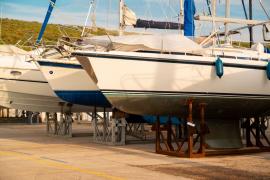
Sailboat Keels Explained
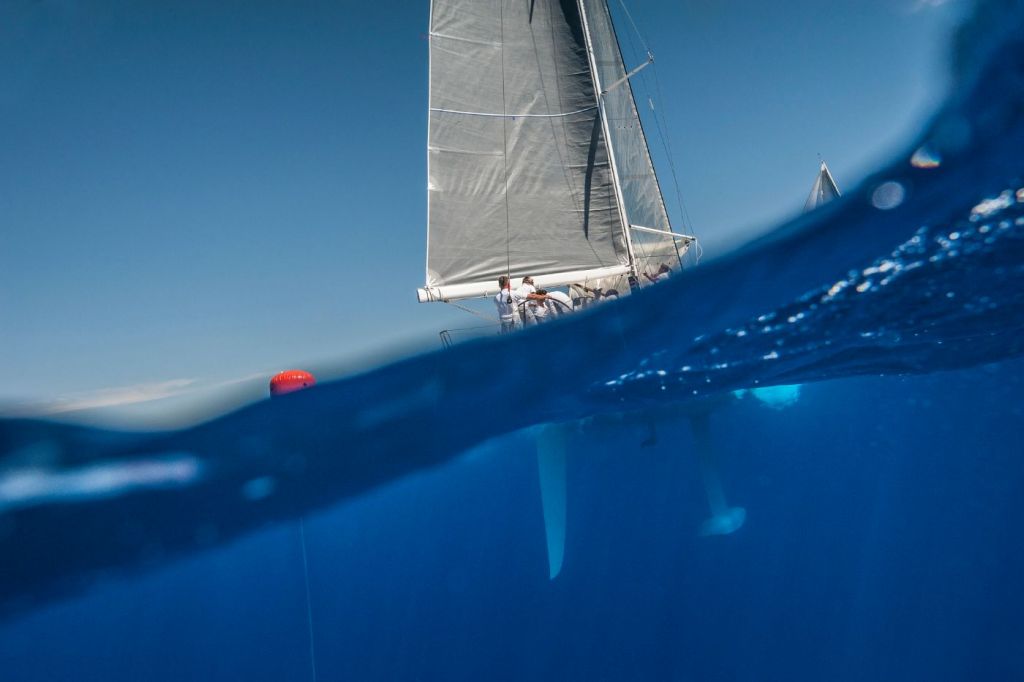
On this page:
Overview of sailboat keel types, keel types: fundamentals, modified full keel, centerboard.
If you just want a quick overview, here's a list with the most common keel types and a short description. More detail will follow below.
The most common keel types
- Full keels run from front to aft and are the most stable keel type, making them the most popular cruising keel.
- Fin keels offer the best performance but are less comfortable. This makes them popular for racing. Fin keels are bolted on to the hull and generally run deep and thin.
- Bulb and wing keels are both variants on the fin keel.
- Bulb keels carry additional ballast in the tip, making them more stable.
- Wing keels have two tips at the end of the keel, which reduces crossflow, improving directional stability.
- Bilge keels are double fin or double full kees, which allows the boat to be beached, making them the most popular keel for tidal waters.
- Lifting keels are moveable keels that can be lowered and raised, allowing the boat to enter shallow waters as well.
- Centerboard keels are a pivoting lifting keel, allowing to sail both coastal and inland waters.
- Leeboards are fins on the sides of flat-bottomed hulls boats, making a keel unnecessary.
Properties of each keel type
| Keel type | Comfort | Maneuverability | Speed |
|---|---|---|---|
| Full keel | +++ | -- | -- |
| Modified full keel | +++ | - | - |
| Fin keel | - | ++ | ++ |
| Bilge keel | + | + | - |
| Lifting keel | - | ++ | ++ |
| Leeboards | -- | -- | +++ |
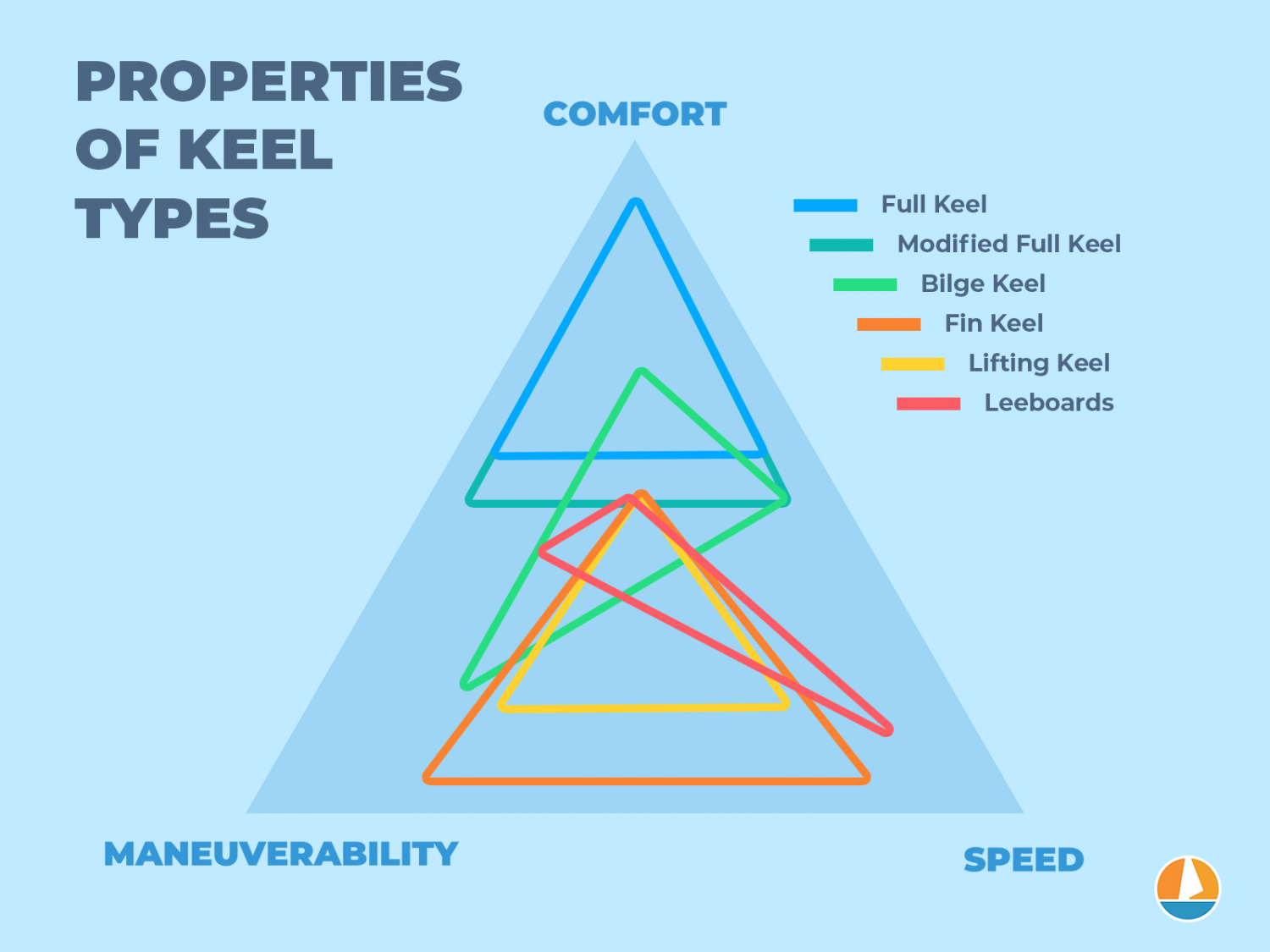
What does a keel do?
What does the keel do? A keel is a vertical blade running down from the hull. It is weighted and acts as a ballast, countering the boat's tendency to heel and preventing it from tipping over. The wetted surface under the waterline reduces slippage to leeward by creating a track, which counters the sideway force of the wind on the sails.
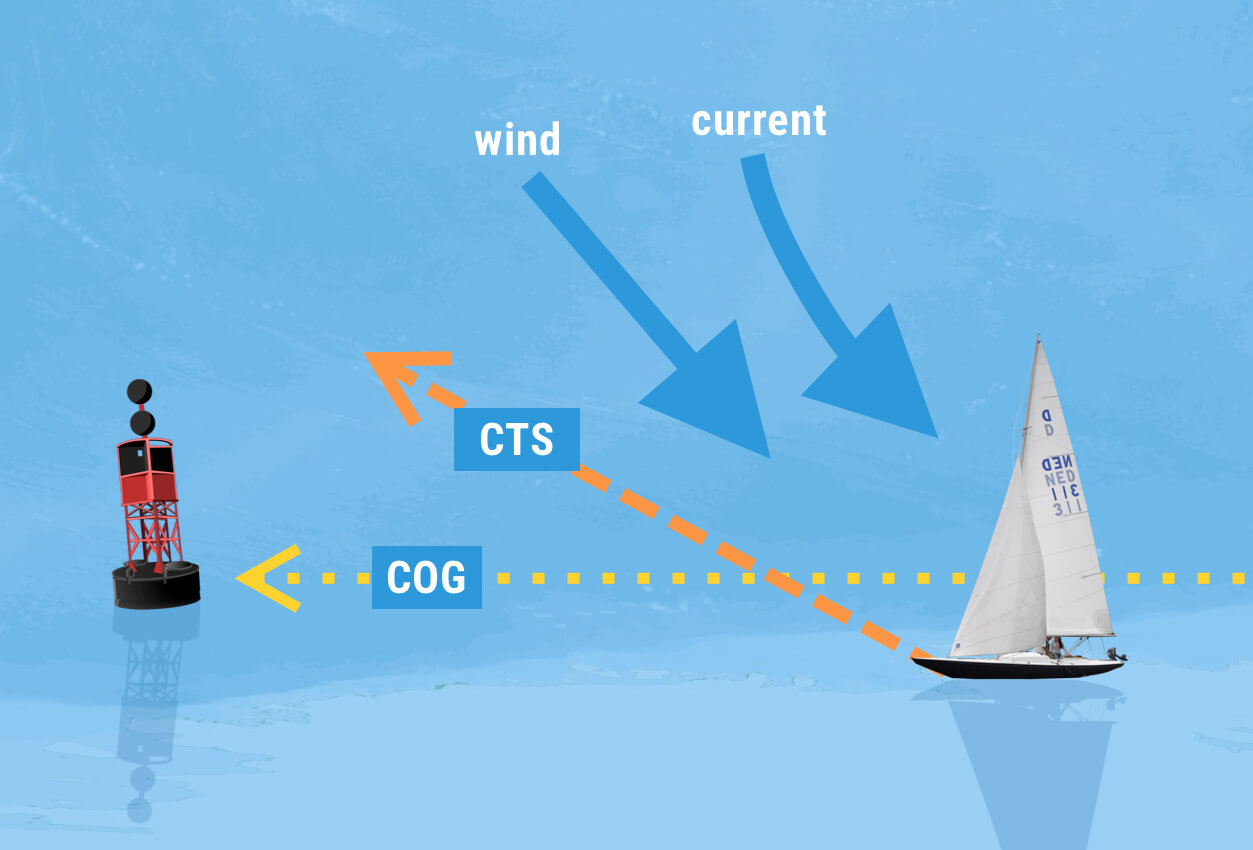
The reason sailboats don't tip over is that the weight of the keel counters the buoyancy of the hull, which means it will pull the boat downward. This downward force reduces heel and prevents the boat from rolling.
A canoe doesn't have a keel. Try stepping into that: it will want to roll.
It counters the horizontal force the wind puts on the sails. Whenever the force on the sails increases, the resistance of the water on the keel increases proportionally.
The heavier the keel, the less heel you'll get.
A keel reduces slippage to leeward. Slippage is simply the amount you fall off course because of the direction of the wind and current. Leeward is the side of the boat behind the wind.
So if you don't have a keel, you will fall off course quite a lot because the wind will push you over the water surface.
You will also heel quite a lot since there is nothing beneath the water surface to counter the force of the wind high up in your sails.
A keel fixes both of these issues and makes sailboats one of the most reliable boats in heavy winds and storms.
You can read on about how keels work here.
Keels can be classified by multiple dimensions. You can look at them from the side or the front. You can also classify them based on properties.
Before I dive into each keel type in-depth and show examples, let's make sure we have the same starting point.
There are essentially two sorts of keels:
Fixed keels
Movable keels.
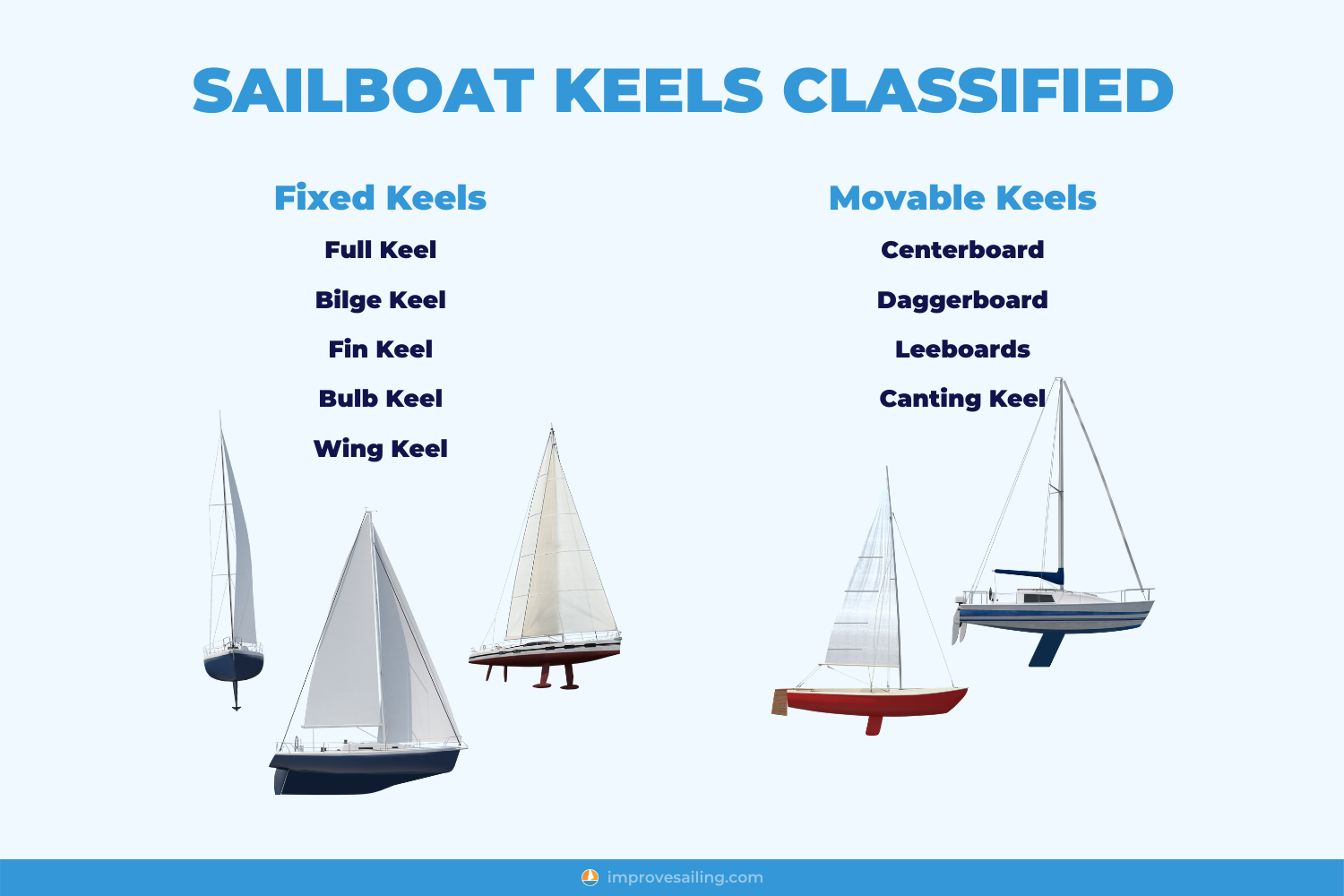
Fixed keels are keels that are integrated into the hull or bolted on. They can't be moved or lifted.
When looking at fixed keels, you can divide them up further based on the side view. There are three main categories:
Bilge keels
Full keels are more comfortable, provide better stability and protection, but are also slower than fin keels.
Fin keels are less comfortable, provide less stability, are more vulnerable, but they're also a lot faster than full keels.
Bilge keels are double keels: one on each side of the hull. This allows them to be beached, which comes in handy in tidal waters. They are generally a lot slower and less maneuverable compared to fin keels.
Movable keels can be lifted from the water, creating a shoal (shallow) draft, allowing the boat to enter both shallow waters and coastal waters. This makes it a very versatile keel type. There are two main designs:
Lifting keels
Lifting keels can be lowered and raised through a slit in the hull. Examples of lifting keels are the daggerboard and centerboard.
Leeboards are wooden swords attached to the side of the hull and prevent slippage to leeward, but they don't stabilize the boat, nor counter heel by adding ballast.
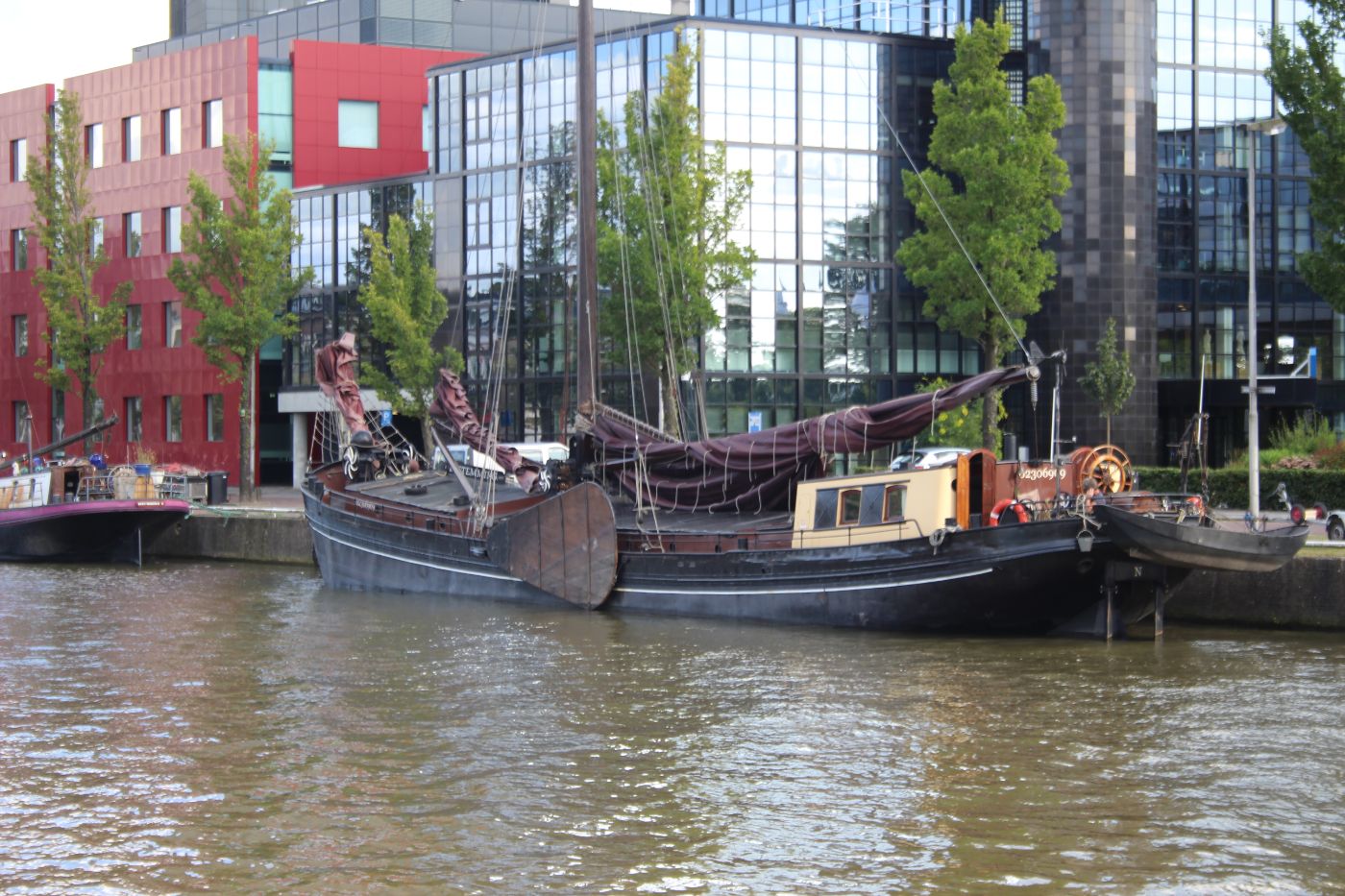
With fin keels, there are different tip designs available. The most common two tip designs are:
These are both variants of the fin keel. Generally, these keel designs are mentioned in one breath with full keels and fin keels, creating confusion on what kind of keel they are. But it's important to understand that they are a sub-category of fin keels.
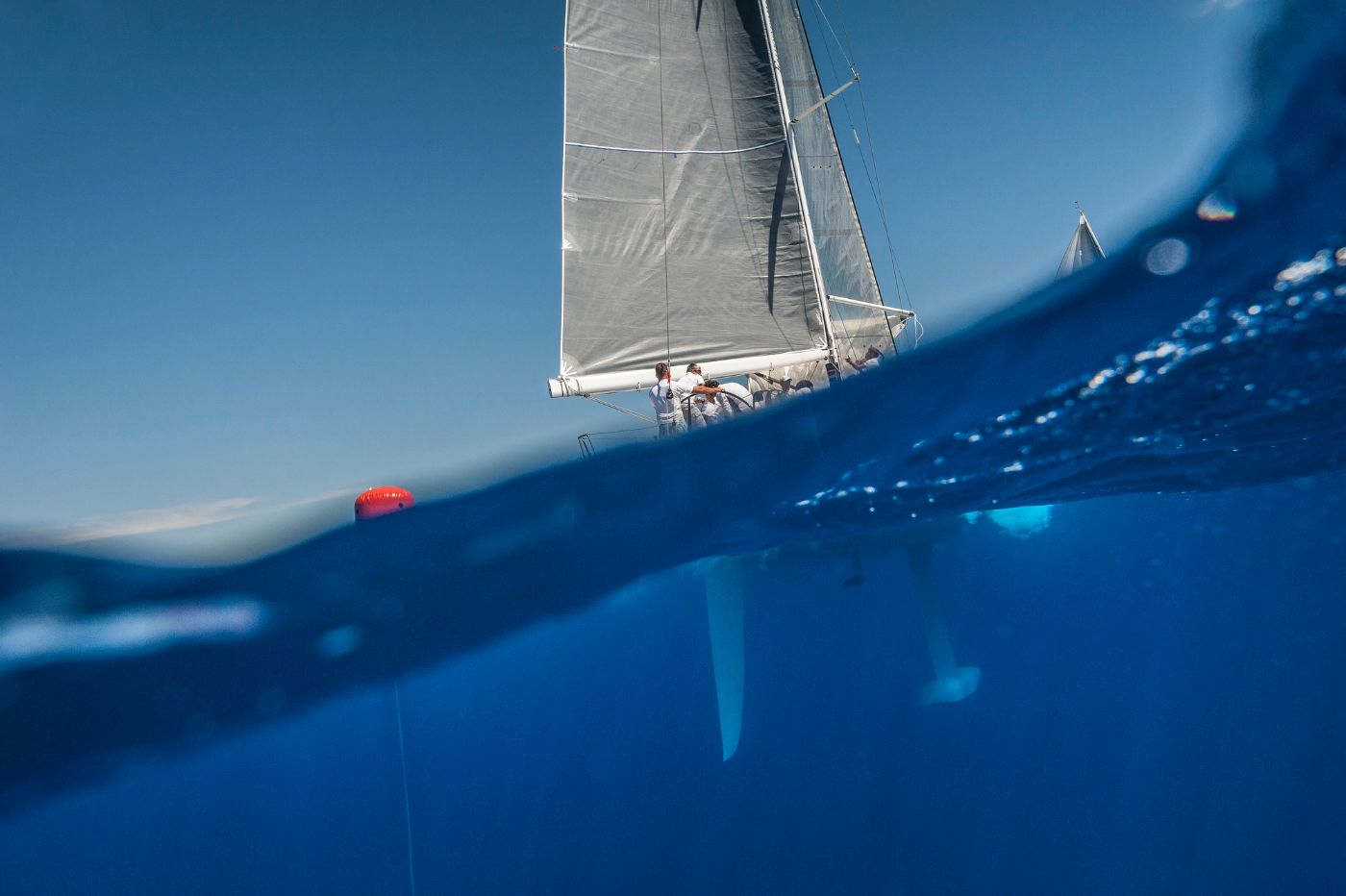
Rudder design
As with the tip of the fin, there are different rudder designs that may apply to both fin and full keels. The two most common rudder designs are:
Skeg rudder
Spade rudder.
A skeg is a structural part of the keel in front of the rudder that protects the rudder. The keel encompasses the rudder, preventing any rogue ropes, weeds, or rocks from damaging the rudder.
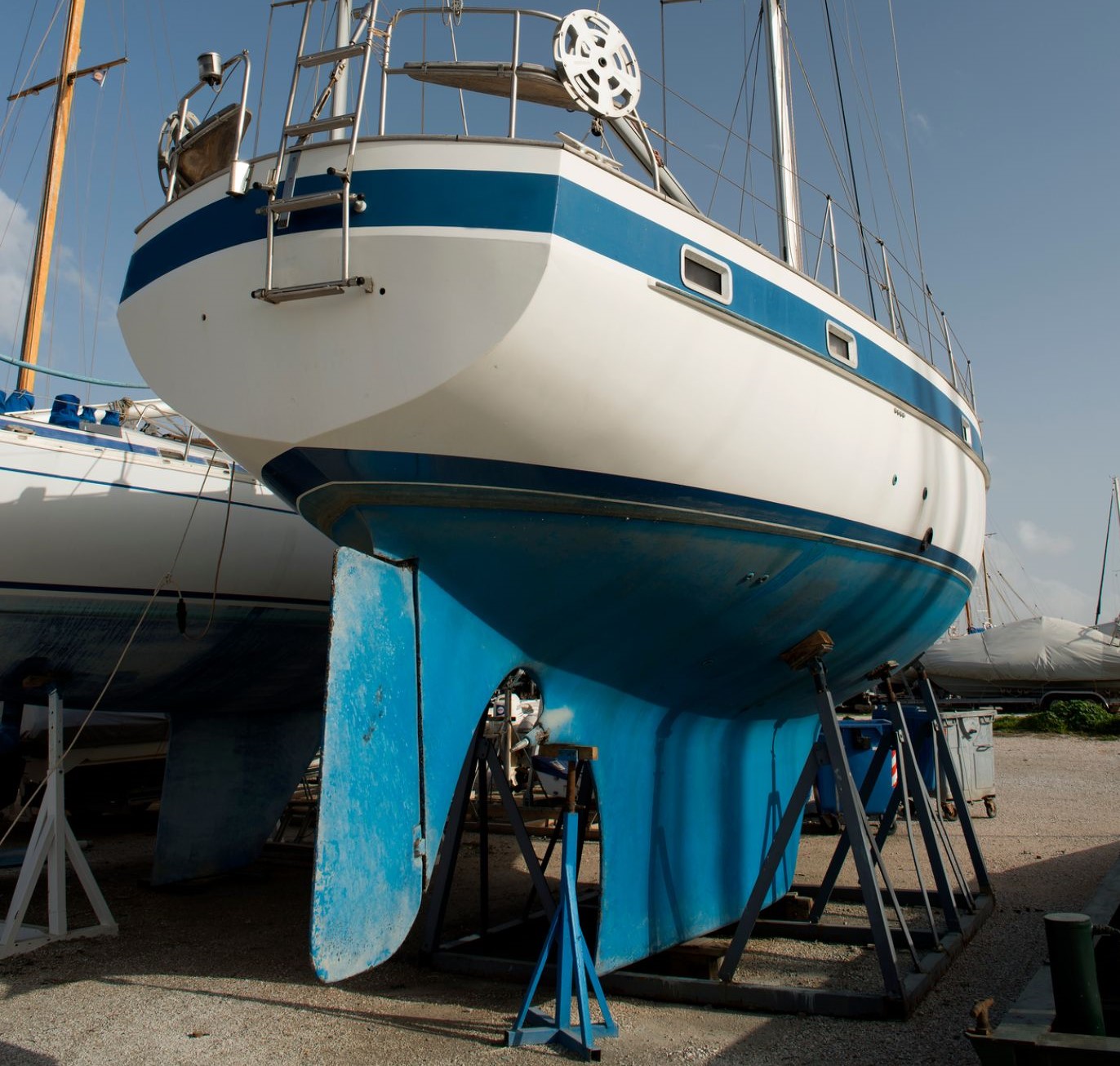
A spade rudder is an unprotected rudder: it doesn't have any structural protection from the keel design. It is simply attached to the hull. This design is very common.
Alright, we understand the big picture. Let's dive into more detail for each keel type and discuss the pros and cons.
Fixed keel Good for cruising and liveaboards Comfortable
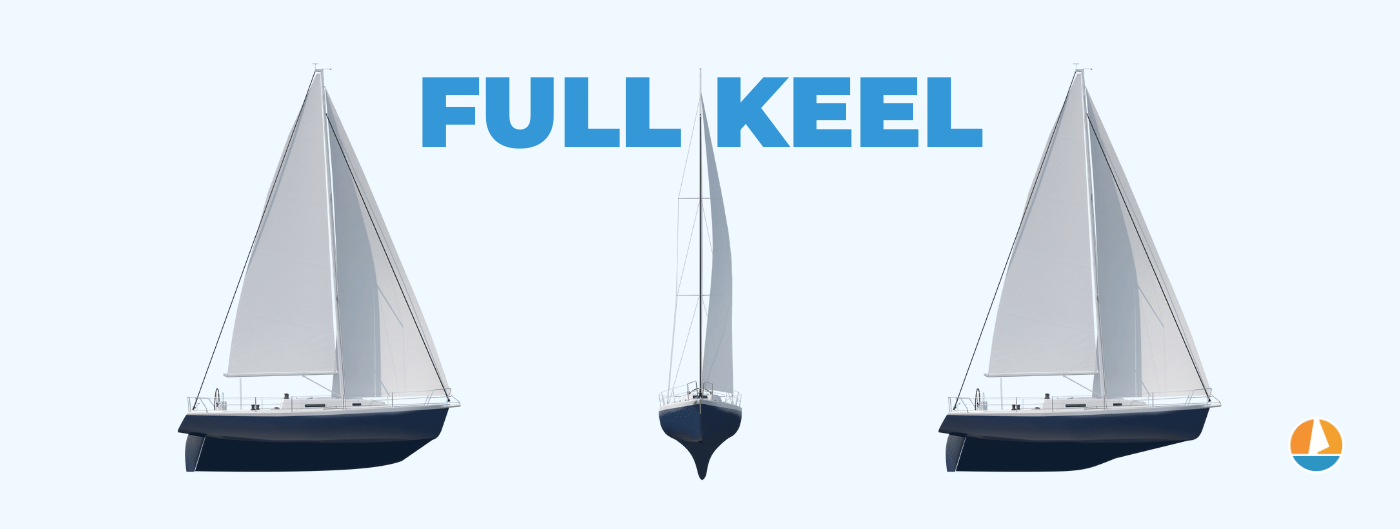
What is a full keel? A full keel runs from front to aft for at least 50% of the hull and is fully integrated into the hull. It has the largest wetted surface of any keel type, and it is also the heaviest. This results in directional stability and reduced heeling, providing the most comfortable ride, but also the slowest.
The wetted surface simply means the amount of water contact area. With such a large wetted surface, it decreases slippage to leeward the most of all keel types, while it counters heeling the most as well.
The full keel is the most comfortable and stable keel type available. However, comfort comes at a price. It delivers the worst performance due to this large wetted area. It is the slowest of the keel types, and it has the worst windward performance.
This makes full keels particularly great for longtime cruisers or liveaboards who prefer comfort over speed, but less ideal for daysailers who need to navigate in and out of slips regularly.
Since it runs for at least 50% of the hull, it doesn't need to run as deep as a fin keel, resulting in a more shoal draft.
Heavier keels result in increased displacement, so a full keel boat will need a larger sail area to compensate for its weight.
For a more detailed discussion on full keel advantages, I recommend reading William's excellent article 5 Surprising Advantages of a Full Keel Sailboat here.
Example sailboats with a full keel:
- Nicholson 22
- Island Packet 380
- Beneteau Oceanis 411 Clipper
- Beneteau First 50
- Jeanneau Sun Shine 38
- Dufour 455 Grand Large
There are a lot of great cruising boats with full keel designs , some of them considered classics.
Full Keel with skeg rudder
Full keels with a skeg rudder design have a protected rudder, thanks to putting a structural part of the keel directly in front of the rudder. This helps with fending off any hazards to the rudder, like floating pieces of rope, rocks, or garbage, and protects it in case of running aground. The skeg design ensures the rudder is nearly impossible to break off.
Fixed keel Good for cruising and liveaboards Faster than a regular full keel

What is a modified full keel? A modified full keel is a full keel with a cutout at the front, reducing the wetted surface slightly, which increases performance without sacrificing too much comfort and stability. After the full keel, it has the best directional stability and the least amount of heel.
The modified full keel is popular among (bluewater) cruisers, thanks to its increased handling and performance. Most modified full keels have a skeg rudder, ensuring it is well-protected.
The slightly reduced weight and wetted surface improve windward performance quite a lot, but it is still one of the most stable keel designs out there.
Example sailboats with a modified full keel:
- Hallberg-Rassy HR 40
- Dufour Arpege 30
- Beneteau Oceanis Clipper 281
- Jeanneau Sun Odyssey 37.2
Fixed keel Good for racing Fast
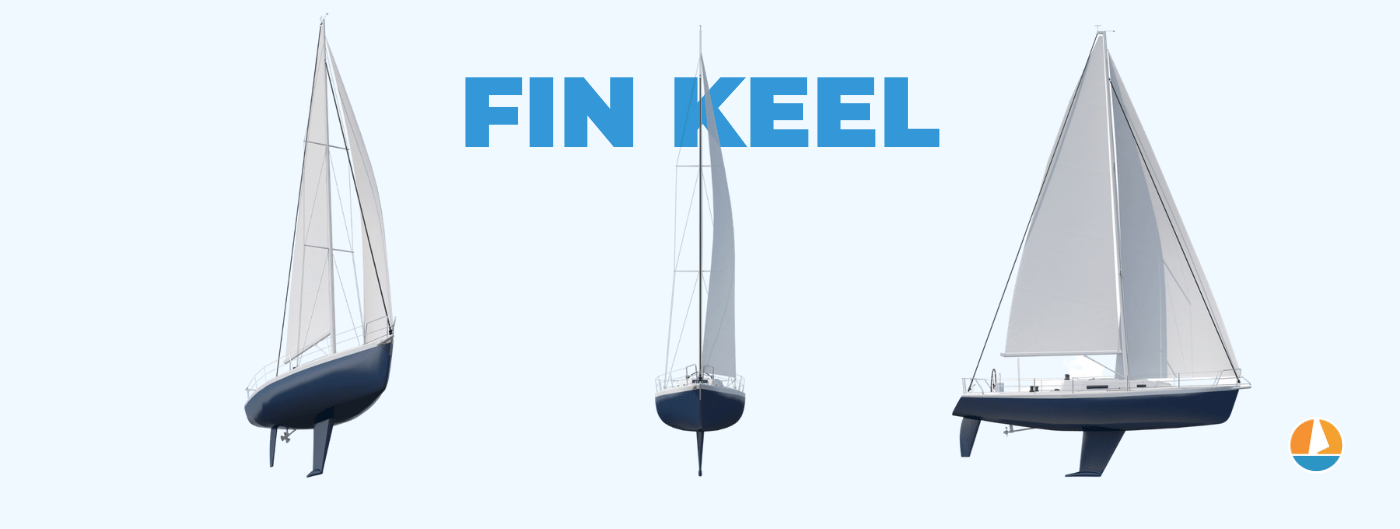
What is a fin keel? A fin keel is a long, weighted blade attached to the bottom of the hull. It is lighter, faster, and more maneuverable than a full keel, but also more vulnerable. The increased distance between ballast and sails provides a lever, reducing the need for a large wetted surface or additional ballast.
Fin keels are generally bolted onto the hull and run deeper and thinner than a full keel. They are also lighter. This helps increasing performance (a lot), making fin keels a lot faster in all situations.
There are some major disadvantages to fin keels, however. Fin keels are a lot less comfortable than full keels and allow for more heel and a less solid track, so less directional stability. Fin keels are also a lot more vulnerable than full keels. They can break off when running aground, or get damaged.
They are very popular among racers and perform better when maneuvering in tight spots, like getting in and out of slips.
Example sailboats with a fin keel:
- Catalina 30
- Jeanneau Sun Odyssey 36.2
Fin keel with skeg rudder
Fin keels with a skeg rudder use a small structural part in front of the rudder to protect it. This design is mostly integrated into the hull, making it less vulnerable, and a great compromise between speed and safety.
Fin keel with spade rudder
Fin keels with a spade rudder have a completely exposed rudder, and typically a fin that is simply bolted on. The keel isn't integrated into the hull, making it more vulnerable and less comfortable.
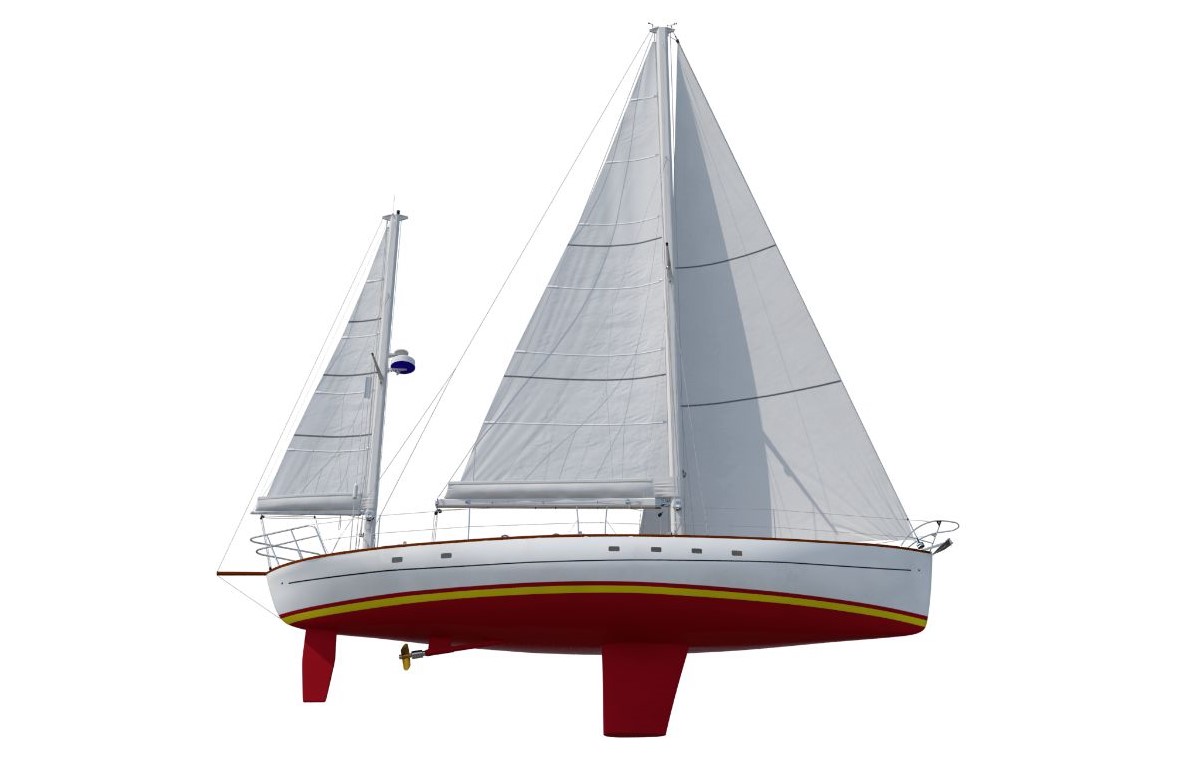
Fin keel variant Good for cruising Less crossflow
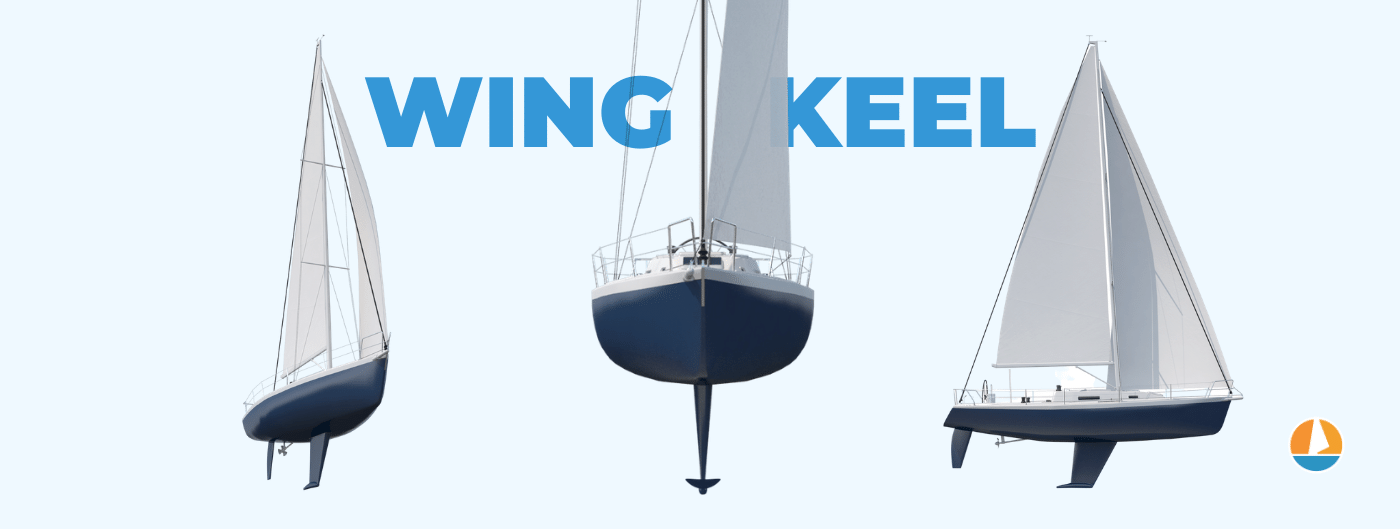
What is a wing keel? A wing keel is a fin keel with a horizontal foil at the tip, which is wing-shaped and generally weighted. Its shape reduces crossflow, improving directional stability, and its ballast decreases heel, resulting in a more comfortable ride. The addition of a wingtip allows for a shorter fin, reducing draft.
Wing keels are good for cruising since this design improves directional stability compared to a regular fin keel or a bulb keel.
We'll discuss the wing keel's advantages and disadvantages in more detail in this article.
Fin keel variant Good for cruising Stability
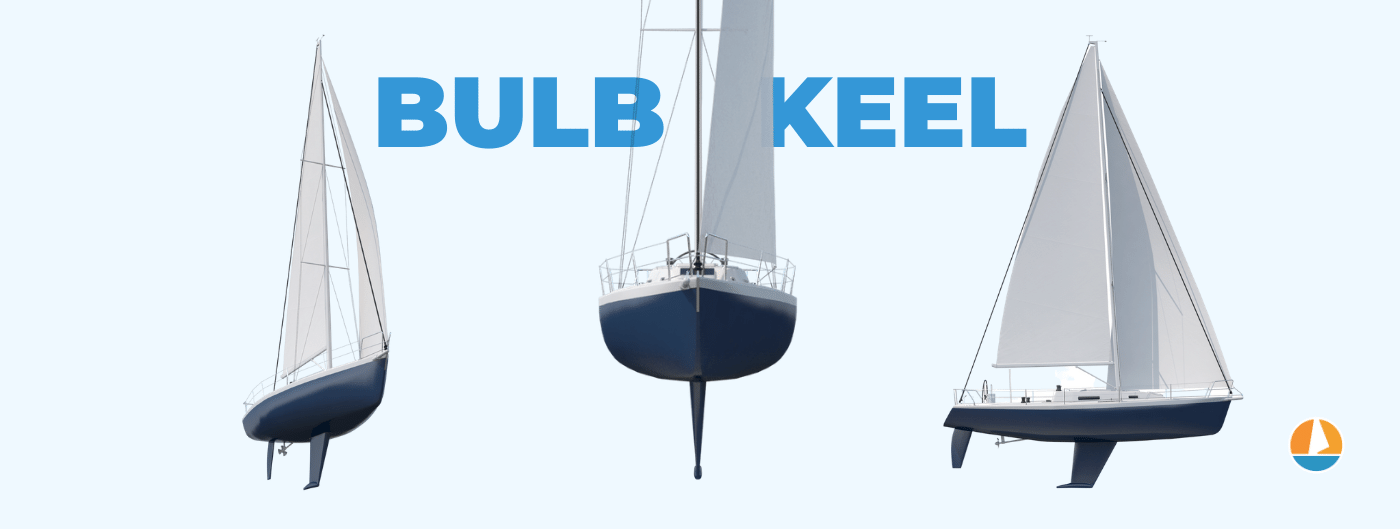
What is a bulb keel? A bulb keel is a high-aspect-ratio fin keel with additional ballast at the end, which generally has a bulb or teardrop shape. This ballast improves stability and utilizes the distance between force and counterforce as a lever. This design reduces the need for a deep fin, resulting in a shoal draft.
By placing the weight at the largest possible distance from the force on the sails, you need relatively little extra weight for the same reduction in heel, making bulb keels very effective for cruising.
This design reduces the wetted area while increasing the weight of the keel just slightly, which increases sailing comfort big time.
Example sailboats with a bulb keel:
- Bavaria B/One
- Beneteau First 24
Fixed keel Good for racing Can be beached

What is a bilge keel? A bilge keel is a twin keel which uses double fins, allowing the boat to be beached and rest on its keel upright. Bilge keels have double the wetted surface, which increases comfort and directional stability while decreasing heel. Modern bilge keels often provide decent windward performance, thanks to better design.
The bilge keel does sacrifice speed compared to the fin keel but doesn't necessarily offer worse performance overall. Older designs performed considerably worse than other keels and were especially slow.
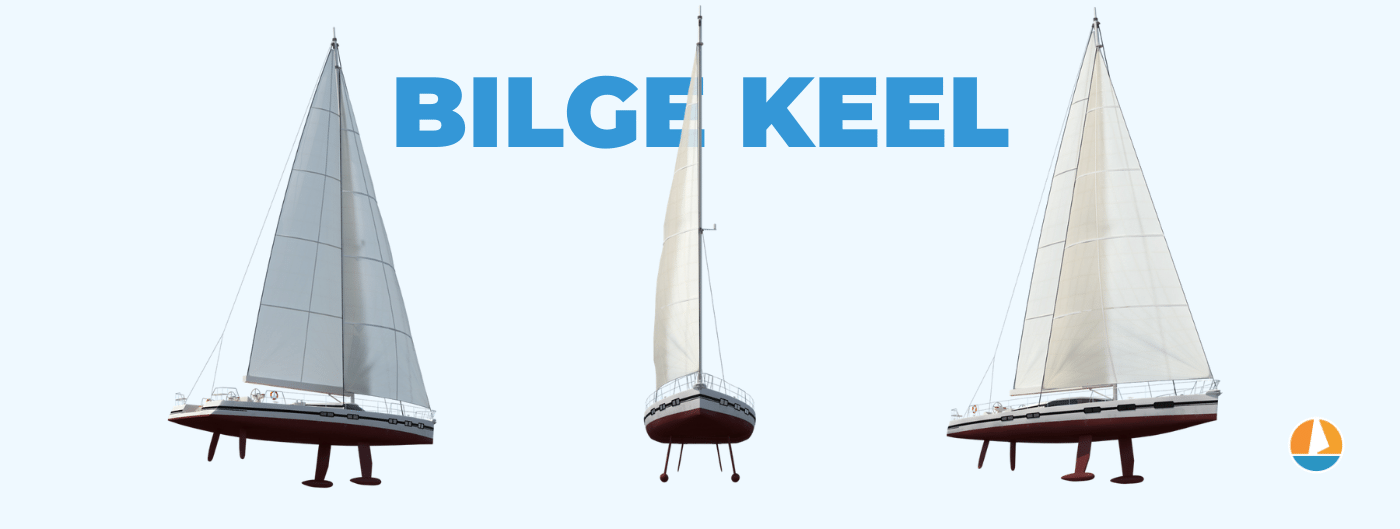
Bilge keels have some major advantages over full keels and fin keels. The most important is that the boat can be beached, making it a popular design in tidal waters. Bilge keels are especially common along the British coastline, where fishermen keep their boats in tidal harbors.
Another major advantage is that the boat can be stored resting on its keels, making dry storage and maintenance a lot easier.
Of course, there are many more pros and cons to the bilge keel , which we go into here.
Example sailboats with a bilge keel:
- Dufour Dynamique 62
- Hunter Duette
- Patagonia Patago 39
- Macwester 27
Lifting keel Good for daysailers Versatile

What is a centerboard? A centerboard is a type of retractable keel that rests on a hinge and can be lowered through a slot in the hull. It folds out like a pocket knife and allows you to increase or reduce the draft of the boat. Centerboards are mostly used on small fishing boats.
The centerboard is a very versatile keel type, allowing you to have both a very shoal draft for inland waters, as well as steadying the boat and reducing heel for larger bodies of water, or even oceans.
I've sailed a Cornish Crabber with a centerboard for a week, and while we stayed inland, having the option to increase the keel depth really came in handy when crossing the IJsselmeer (a former sea in The Netherlands).
There's more to the center
Olaf Roethele
https://www.theyachtmarket.com/en/new-boats/cornish-crabbers/adventure-17/218/
My name is Olaf and I am the owner of a Cornish Crabber 17 Adventure boat.
I would like to ask you if you can imagine to install on this boat a Torqeedo 2.0 Pod motor? Therefore i guess a modification of the keel/skeg is necessary ?!
Best regards from Uruguay,
You completely missed the hybrid planing/water-ballast keel of the Macgregor range
Thanks a lot for this explanation
Roger Bannon
Very well written article which provides an excellent guide for us small wooden boat builders. Thanks.
Leave a comment

IMAGES
COMMENTS
The Southerly 42 RST offers 2.72 metres' draught with the keel down enabling plenty of sail area and good overall performance. A step change came at the end of the 1990s, with introduction of the Rob Humphreys designed Southerly 110. This had a softer, more rounded pilot house design, but the most important changes were below the waterline.
Category Description. Lifting keel as an option is offered by many famous brands - Oceanis, Delphia , Nautor's Swan, Wally, Oyster among others. This technical solution is in demand for boats of all sizes. The use of a lifting keel allows to reduce the draught of the boat when entering shallow water areas (or marinas with shallow depths) and ...
This boat also features a lifting centerboard that reduces the draft by 2' 7". Depending on the year and the seller of the vessel, these boats are selling for an average price of between $30,000 and $45,000.00. 7. Norseboat 21.5. The Norseboat 21.5 is the largest model in the Norseboat line with a length of 21' 10".
One of the larger boats on this list, the Seaward 26 RK, is still easy to move over land with a trailered weight under 6,000 pounds. The boat alone displaces 3,800 pounds, with 1,200 lbs. of that in retractable ballast with a bulb on the bottom. The keel lifts with an electric motor and is simple to operate.
Hunter 22. This one has to make the list because it is immensely popular. Rightfully so. It is small enough to be transported on a trailer, plus it has a lifting keel that makes the draft only 30 centimeters when up - but over a meter when down, so it still has to say a lot in terms of performance.
Consider the fact that the standard draught of a Jeanneau SO410 is a conservative 2.25m and the shoal keel version just 1.6m deep. Alternatively, this lift keel version reaches down to 2.97m/9ft ...
A swing keel, also called a lifting keel, is a type of sailboat fin that can be retracted through a slot in the hull, which reduces draft and allows swing keel sailboats to navigate shallow waters like rivers. The keel rests on a frontal hinge and is generally lowered using a hydraulic ram. Having a swing keel has some unexpected advantages ...
Potentially the least expensive Category A lift keel boat available, the Ovni will get you dreaming of remote places again. Ovni 370 price: €282,080. There's no shortage of spirit in the ...
Best of Both Worlds. The expert design team at Beneteau Sailboats has implemented a safe, stable, & convenient system to package the advantages of both deep and shallow draft keels. A hydraulic lifting keel offered on the Oceanis 34.1 maximizes the hull's potential when deployed, yet gives access to shores with shallow waters when retracted.
GT35. Since the heyday of bilge-keel boatbuilding in the 1970s and 1980s new boats have, on average, become larger. At the same time design has continued to progress, with the result that the bilge-keel version of the GT35, a new British built high-quality cruiser, is likely to be one of the fastest twin-keel boats you'll ever come across.
With its distinctive range of bare aluminium lift-keel cruisers, Alubat's Ovni brand has been synonymous with bluewater cruising since the 1970s. After a barren period it came out with a ...
A rugged aluminium sailing yacht with a lifting keel for exploring remote cruising destinations. LOA: 56'-2" LWL: 47'-4" Beam: 15'-10" Draft (keel up): 3'-2" Draft (keel down): 8'-9" Displacement: 55,000lb Ballast: 21,460lb Fuel: 507gal Water: 258gal Engine: John Deere 4045TFM 135HP@2500RPM. A young couple in Capetown, South Africa, with two ...
The lifting keel (at 5,15m draft) has the next best upwind performance while the fixed keel is strongest in power reaching conditions. For performance versus rating the lifting and fixed keel versions are essentially equivalent over a balanced race course with the advantage going to the lifting keel for more upwind-downwind oriented races and ...
Best cruising boats under 30 feet: Lifting keel options. If you prefer a lifting keel boat around the 30ft mark, the Tony Castro-designed Parker 31 that was built by Parker Yachts between 1987 and 1993 is worth a look. For a high performance yacht, it offers good accommodation with double berth cabins in the forepeak and aft as well as a ...
The brand Aeolos Composites produces lifting keel sailboats and one-design racing keelboats. There are 3 models currently in production ranging from 9 to 16 meters. The current model range includes 2 lines: Motor and Sailing. We invite you to explore all current and older models from Aeolos Composites and contact us for sales and pricing ...
The 13 most popular swing keel sailboats that you may find worthy to consider are the following: Catalina 22, MacGregor 26, Hunter 22, Precision 23, O'Day 22, Beneteau First 235, Seaward 25, Islander Bahama 24, Watkins 27, Com-Pac 23, Montgomery 17, San Juan 23, and West Wight Potter 19. The estimated pricing for the boats with swing keels ...
For this, OC designed a manual lifting lift keel and torpedo bulb, providing a minimum draft of 1.05m and max draft of 2.6m. The hybrid fin and deep sailing draft results in a relatively light sailing displacement of 6,500kg. The sail plan includes a modest pin-head mainsail of 54sqm.
The Drascombe Coaster, Blue Peter. The coaster is 21ft 9in LOA. Pocket cruisers: the best boats between 17-20ft. Selecting a pocket cruiser or any boat can be a bit of a lottery. Especially if it's getting on a bit. If you are looking at a brand-new model you can of course ask the dealer for a trial sail.
A swing keel has a ballasted fin that has a single pivot point and the keel swings up into the boat. Technically, a lifting keel is a keel that can be lifted or lowered and gives the boat the ability to dry out when the tide goes out. A lift-keel is a ballasted keel that raises and lowers vertically. ... but a lot of owners come to us thinking ...
The best keel types for speed are canting keel, bulb keel, and wing keel. For improved maneuverability and agility, the best keel types are swing keel, ... The structural integrity of a boat with a lifting keel can be compromised if it is not designed and engineered properly. This could lead to stress points or even failure in extreme situations.
20m Explorer Yacht. QILAK IS FOR SALE AT: OC BROKERAGE SERVICES CONTACT: [email protected] The Owen Clarke custom designed 66' sailing expedition yacht Qilak was launched in September 2018 at K M aluminium Yacht-Builders yard in Makkum, Holland. Purposeful, 'half yacht and half working boat', aptly described as a Land Rover ...
Bavaria 40. The Bavaria 40 went into production in 2000 offering accommodation volume first and foremost, with a shoal-draught keel option. This is a boat that was designed to deliver plenty of space at a price that other manufacturers could not beat. This was primarily the result of economies of scale and careful production engineering.
The most common sailboat keel types are full-length keels, fin keels, bulb keels, wing keels, bilge keels, and lifting keels. Full keels are popular among cruisers, while fin keels are generally used for racing. Bilge keels and lifting keels are typically used in tidal waters, on small fishing boats for example.